#how they made the 3d model. the map. the soundtrack
Explore tagged Tumblr posts
Text
Zim screenshots i did because i bought that new game today
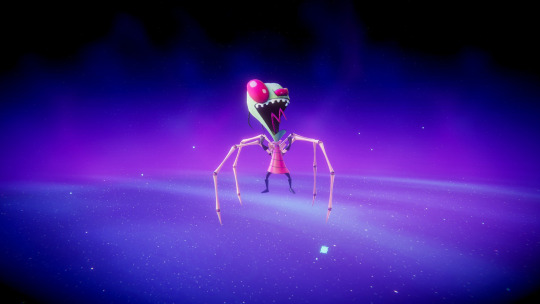

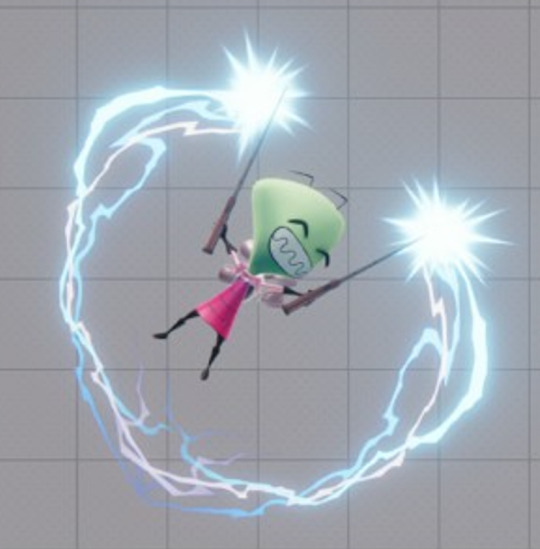

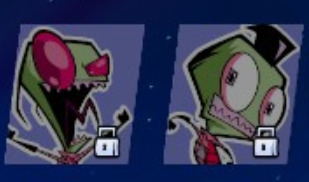
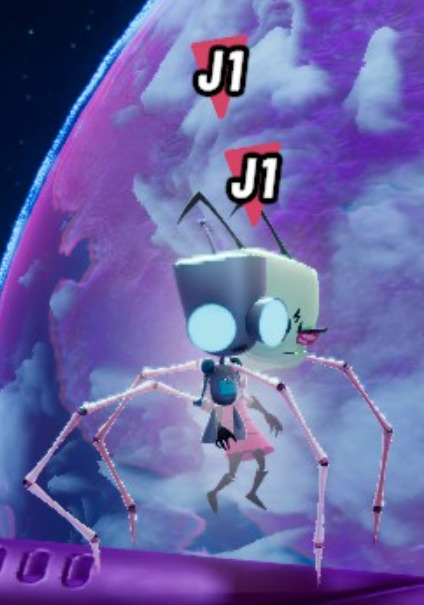

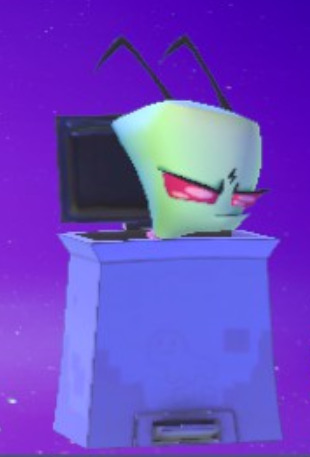
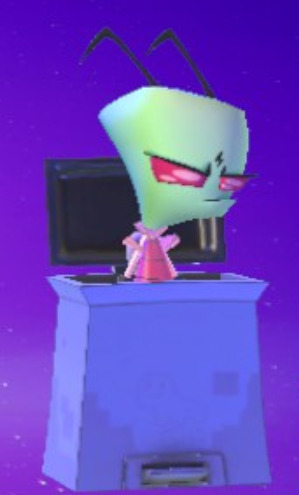

He's his own enemy /hj
#i love everything of this#how they made the 3d model. the map. the soundtrack#MAN THE SOUNDTRACK#IT'S REALLY COOL#... at least for me. idk#iz#invader zim#zim#iz zim#gir#iz gir#nickelodeon#nickelodeon all star brawl 2#nasb2#video games#screenshots#my screenshots
553 notes
·
View notes
Text
HoO Devlog #1
Hello! This account will be for posting updates on my attempt at creating an rpg game using me and my friends' original characters. The game is tenatively named Heroes of Odyria and will be created using the Godot game engine.
I begin the development of this game with zero experience in any department of game development, and I aim to learn and become better at every single aspect of the process on my own.
Since beginning this development journey on May 3, 2025, I have since learned how to set up the basic game and movement in Godot, using some quick sprites I made from the art references my friends gave me of their OCs. I meddled with the 3D game aspect of Godot in hopes of creating this game in a "HD-2D" style similar to Octopath Traveler or Dragon Quest III Remake, before determining that the art involved with pixel-style 3D models is currently out of reach for me, skill-wise, who has zero artistic experience. I then refactored what little code I had from 3D to 2D and began taking heavy inspiration from games like Sea of Stars and Stardew Valley.
Currently, I am taking pause on the actual coding and game-dev aspect in order to work on pixel art and drawing some assets to use in the game. Once I have some basic assets for my first scene, I want to storyboard and figure out how to work my own dialogue manager into Godot.
I will do my best to have a "no zero days" approach to this journey, meaning everyday I do something related to the game instead of zero things, even if its something small like changing a few pixels in the art.
This week I decided to redesign my character sprites to better fit the artstyle I want to see in my game. This blueish character is my personal OC, Yuxiel. I am constantly changing his lore as I go, but hopefully I can finalize some of the lore details as I work through this game. Today I worked on what I intend to be my first scene: a throne room. It is very barebones but it will let me have something to look at while I continue development. I also created a basic map to help me with the storyboarding of my game plot, and created some song snippets to brainstorm the game soundtrack.




3 notes
·
View notes
Text
What Can I Do?
24/02/2025 To figure out what I can do for this project, I must look at what I can do well in general. This links back to the previous 3 course projects I have done so far in the current academic year. These being: The 2D Platformer Project, The 3D Environment Project, The 4D Arcade Project, These 3 projects worked relatively well in the past so I can make some notes on things that I did in them. Game Development: The core concept of game development as a whole. The final product being a digital executable made for people to enjoy playing is common among the 3 projects. This would be a good basis for something I could do for the FMP. How I get the project made could be completed in many ways that I need to go over. For the game programming itself I could use a specialized game development engine like Unreal Engine, Unity, Gamemaker Studio: 2, or Godot. 2D Pixel Art: I was quite happy with the flat pixel art sprites I made for the 2D Platformer and the pixel UV maps I made for the 4D Arcade Game. I could make something related or revolving around pixel art. This would probably not do very well considering that I don't feel comfortable with being able to make something large using entirely pixel art by itself. I could either make a single image or an animation with it. Alternatively, I could combine it with other concepts to relieve some of the heavy lifting off of my art skills. 3D Modelling: The 3D modelling I did for the 3D Environment and the 4D Arcade Game was quite useful for giving the project life. Out of everything I am mentioning here, this is probably my weakest skill. Not weak enough that I couldn't base an entire project around it, but definitely the hardest one to do out of all of these. I could do modelling, texturing, animating, rigging, motion tracking or anything else related to 3D artistry. Music Composition: For the 4D Arcade Project, I composed my own original soundtrack for the game. There were not many songs nor did it take me very long to make them. But I could absolutely spend more time on music as a whole and make a composition or composition collection for the FMP. This would probably be my last resort since it would be much harder to explain everything and give detailed enough descriptions of everything I am doing. This would be a troubling topic by itself, but would be useful when pairing it up with something else. Now listing the skills I could use to create my project, I will need to combine this and the mindmap concepts to generate ideas for my final project. I will likely be making a whole game so I can show and describe many skills at a time, so I'll think of my concepts with that in mind.
0 notes
Text

Lazzle's Rune Factory 5 Review
Alright so here are my thoughts and experiences with RF5! This is a big boy so buckle in earthmates...
Obviously this review will contain spoilers, read at your own risk.
Initial thoughts upon playing...
Great opening! I enjoyed the jazz music~ I did feel like it leaned a bit more towards the male player though. It definitely feels like a rune factory game. It's familiar, and controls are easy to get accustomed to for the most part. The mold is there and rf5 doesn't stray too far from its predecessors which is comforting for veterans. That being said, I'm not going to pull any punches and will critique this game harshly. Keep in mind as updates for the game are released not all things discussed in this review will be as relevant overtime!
Let's hear some thoughts on...
The story/plot. The plot is enjoyable overall. I'm not crazy about the whole Seed organization thing but it was a neat idea. They address the Sechs Territory and it is confirmed that the game takes place some decades after RF4. But by the end of it, I didn't feel like I really accomplished anything because it felt like I barely did anything really. Also they left a lot of stuff unanswered. I'm not even sure I understood the message they were sending, if they were trying to send a message at all. The main story is too short, and it doesn't involve enough of the townsfolk. You're basically doing everything yourself in secret the whole time and the townsfolk barely know what's actually going on. Out of the love interests, Lucas plays the largest part in the story, followed by Priscilla and Scarlett. The story feels targeted at male audiences--at least that's how I felt. You, the player, have a larger role in the game, much like in RF3 and I was glad to see this. As of right now there are only two arcs. Praying for DLC 3rd arc...!
Protagonists. The latest protagonists to join the crew of Earthmates are...decent. Their designs are nothing special unfortunately, though I appreciate Alice's more than Ares's. Appearance-wise they lack personality and creativity. Personality wise I am pleasantly surprised with how sociable they are. They're not exactly quick witted and sassy like Lest/Frey were in rf4, or as endearing as Micah in rf3, but they have a certain realness to them that makes their reactions to things believable. I'm certain Xseed will see to making them a bit more sarcastic in their localizing efforts, so let's all look forward to that. Overall though, while I appreciate their mannerisms, they don't really measure up to all the previous amnesiacs we've grown to love over the decades.
Characters. Overall I enjoy all the characters introduced in Rune Factory 5! I feel like there is someone for everyone in this game on some level. The voice acting was pretty good for every character. The designs are very much Rune factory. Like OG runefa, compared to rf4 ( 4 kind of strayed from their usual style) which I like. Characters still have their own signature quirks that you find endearing. Although I would have liked to see more variety? Like we've had mermaids, univir, half monsters, vampires, etc in previous titles but rf5 only gives us the usual (half) elf, dwarf, and then a succubus (physically she doesn't have unique features aside from the ears and heart eyes), and some were-people. I was hoping for something more unique to really give that classic runefa vibe.
Dungeons/Battles. I'm pretty split on this one. On the one hand, the dungeons have more depth due to the 3D aspects. They've included more contraptions that are very fun to see even if they aren't executed that well. So I'm grateful for that. On the other hand, the dungeons are insanely short imo. It doesn't take long at all to get to the boss. The puzzles are also pretty subpar and few compared to RF4. Fighting monsters is similar to the other games. You can lock on now but I only use it when I'm trying to use my Seed Circle. The lock on feature is actually counter-intuitive and makes it harder to dodge. Weapon mechanics have shifted a bit. There’s a feature that makes you invincible to damage if you time the R button dash correctly. Axes and Hammers are significantly slower than in older games? Like. I thought I was in slow motion it was so slow. Lances are also harder to use as well? I'm questioning my sanity here. I don't know if it's a bug or intentional either.
Farming. Not much has changed from previous games mechanics wise. They added new types of special crops which is neat. The camera view changes to overhead when you go near your fields though, and it can make you dizzy/uncomfortable. It actually makes it a bit difficult to see at times so I wish there was a way to adjust the angle. If you are tilling corn or dried weeds to improve the soil, you need to place them separately if you don't want to use the entire stack. Otherwise, it will till the entire stack on the land if you place them all down at once. The flower shop is unlocked late in the story. Weird thing to do considering you need flowers to make medicine. Not to mention the fact that you wont have access to the fertilizer that increases defense against typhoons? During typhoon season? Thinking emoji...
The town. I have to say Rigbarth's design is poor compared to Sharance, Selphia, etc. It's too big and it takes too long to get around. Everything is too spaced out and there aren't enough warp points to make it easier on players. I don't want to walk an entire mile up a hill to talk to one person and then walk all the way down to the beach to speak to another. It doesn’t really feel like a ‘town’.
OST/BGM. Music was good, though nothing really stood out to me where I'd go "damn this slaps" or something. I think they might've had some old soundtracks from rf2 or something because it felt really nostalgic at times.
We need an exterminator. (Bugs Bugs Bugs)
Marvelous, I don't know how to tell you this buuut...your customers are NOT your testers. When you release a game, you need to make sure it's not littered with glitches because customers don't enjoy dealing with them and will drop the game!
Here are some of the types of glitches I encountered:
Crashing. Game would randomly crash or freeze and close at any moment. Sooooo frustrating! Sometimes you get lucky with the autosave feature, but the autosave only activates every morning at 6am in your room and then when you warp to a dungeon level/floor. So when you're in the middle of your daily tasks in town and it crashes, you have to start all over. Marveloussss no one enjoys losing their progress in a game I promise you that much.
Lag. The dialogue bar is seriously slow, especially after loading your file. Crafting/Cooking screen lags. When you press the Y button to skip through dialogue it lags like hell. Pretty much after every time you load the game will lag, the audio will lag if you're in a battle, everything is just. so. slow.
Repeating dialogue. So if you close your game entirely (or if it crashes) naturally you'll reload your file to continue where you left off. There's a bug that will cause all NPCs to repeat the last dialogue that occurred from whatever plot related thing you did last. So for example, if the last thing you did in the story was unlock Ludmilla, everyone in town will naturally have some dialogue about her. But even after seeing all this dialogue and even saving, if the game is closed and reloaded you'll have to read all that dialogue again from townsfolk. It got really annoying after a while.
Monster taming. One time I tamed a monster but once I named it and hit 'ok' the monster never showed up in my barns? Just. gone. Okaaaay then...? Additionally, I expanded one of my monster barns but all of the monsters I tamed wouldn't appear in the added room. You get 4 monsters for each room but the monsters I tamed would show up in the original room. Meaning I had like 7 monsters in one room! I tried to bring them into the newly added room but they would just warp back to the other room. Sad.
Pond Glitch. I fished in the pond located in Sasayaki Forest and left the fish I caught but didn't want laying around the water's edge. If you leave fish around the pond's edge and go to sleep, the next morning you will be teleported to the pond and trigger the fairy dialogue as if you had thrown all of the fish into the pond??? So the dialogue of her telling you she wants 'X item, not this!' will trigger over and over for all of the fish you left at the water's edge. RIP.
Party member Bug. I had Martin in my party and I made him leave. Then when I went into my monster barns to get a monster pal to join me instead it showed me Martin's portrait???? Also I've encountered a bug where I can no longer ask anyone to join my party for some unknown reason. The R &L button prompt was just gone when I reloaded.
Errors. When cooking or crafting, the dialogue box shows up sometimes...
Typos. Random average typo here and there. Not a real biggie but there is one instance where the heroine will use the japanese male pronoun "boku" instead of "watashi" which really convinced me that this game was completely intended for men lol.
Let's talk about Pros
The good stuff. The stuff that makes you all warm and fuzzy inside.
Plot Advancing. Now I'm gonna put this as a pro because I'm certain the average player will enjoy this even though I do not. There are now markers on the map to show you where to go to advance the plot. This is all well and dandy, but it also made the story less appealing for me because you don't need to go around town and speak to residents for clues or assistance to advance anything in the story.
3D Graphics The 3D models are all amazing. The interior designs of the houses/buildings are also incredibly detailed and realistic.
Collecting items. Now there's a feature that will allow you to collect items into your inventory just by walking over them. This is pretty neat and welcome for the most part. Once the item is sparkling, you can walk over it and it'll go into your rucksack automatically. This also makes lumbering and mining go much faster. Yay!
The miraculous L pocket. Now you can customize the categories that appear in your L pocket by going to the rucksack tab in the menu. This is a super neat feature that makes things easier on players who want to manage their items in a format that suits them.
Weapon/Tool Toggling. You can now toggle between your equipped weapon and tool by pressing the left or right buttons on the trackpad.
Collecting lumber/material stone. Oh lord this is probably the most welcome improvement moving forward from the previous game. You can now put all of the lumber and material stone from your inventory into its storage at once. This also applies to fodder for tamed monsters. Well done Hakama.
Autosave. This feature is a welcome addition to the series. The game will save your data every morning and every time you enter a dungeon. Autosave has really saved my ass a few times when I made a huge error in judgement so I'm incredibly grateful for this feature. And it doesn't save over your actual save file--there's a separate autosave file at the very top. So if you messed up something but already saved on your main file, you can still salvage your mistake by reloading the autosave! I just wish it activated a bit more often sometimes.
Warping. Now we can warp to each level in a dungeon as well as certain places on the map in town. It's pretty convenient for the most part.
Increased party members. Now you can have up to 3 members in your party! Hooray! Party members act more intelligently than in older games. Scarlett can use the Seed circle to assist you in fights. I think she also tosses healing potions at you occasionally. So far, no one has tossed a dish at me if I haven't eaten like Kiel and Clorica did in rf4. But I have been hit by a failed dish (from reinhardt?) and a healing potion (from scarlett). Scarlett, Priscilla, and Reinhardt are the most helpful when dungeon crawling in my experience. Some of them however, (looking at you Doug) don't shut the hell up with their one line of dialogue they have and repeat it constantly.
Seed Circle. This neat feature allows you to capture monsters. By charging it and releasing you can capture monsters for the bounty system or add them to your party temporarily. If you throw it without charging it, you can stun monsters in place momentarily or grab things from far away. When stunning monsters, it can also give you the monster's drop item occasionally. Unfortunately it uses a lot of RP so it can be difficult at times.
Combo attacks. This is a neat feature that I appreciate and use often for boss fights. They do some serious damage so it's good to save them for the bosses. The actual cutscenes aren't that impressive, and feel kind of subpar when you get down to it but I think it's a start in the right direction.
Farm Dragons. I'm listing this as a pro although I really just see it as a new feature. Farm dragons have fields on their backs that you can place monster barns on and farm on. Giving them certain crystals will give your fields boosts in certain criteria, like length of growth, soil quality, you get it. I personally don't use the crystals because I couldn't give a shit lmao I have men and women to woo here. But if you're into this kinda thing then it's a pro.
Storage. When opening your storage box, fridge, etc. you can actually hit the R & L buttons to switch between ALL of your other storages. Looooove thissss. Great addition. So much faster to put items away in their respective places.
Crafting/Forging. Now we can also use the R & L buttons to alternate between the different weapon types/accessory/gear types instead of having to exit the menu and going back in each time you want to make something different.
Cooking. More recipes have been added. Yay!
Days are longer now. More time to get shit doneeeee ayyyy
Fishing. They've added many more fish to the game! Now the player will shout something when you get a bite, making it easier for you to hit B at the right moment. Nice. Also if you fail or press B too early, the fish doesn't vanish most of the time. Also nice. There is now a feature to fish with another person's assistance. Once a day you can investigate the sign near the fishing station and someone might offer to lend you a hand. Press the B button at the right moments on the slider and you can get a rare fish that can't be caught normally.
Monsters. New types of monsters! Love the designs. Even the monsters that are the same but just have different skins are really neat. They look great in the 3D format too. You can even ride with up to two people on certain monsters! Some bosses had awesome designs while others...were bad.
New Types of Furniture. The carpenter store has a wide arrange of furniture you can buy for your home. It also has wallpapers and stuff which is really neat. Though unfortunately you can't even sit on some of the furniture so that's a shame.
Events. Now there is a system where events are triggered by approaching an icon on the map. This is probably an improvement to RF4's randomized system, though personally I found it annoying because it meant that I had to see the events before I could just enter a building normally. Sometimes I just wanted to get shit done and not have to read through walls of text for someone's love event when I just want to buy something.
Voiced Lines. The protagonist seems to have more voiced lines, as do other characters. Good!
Let's talk about Cons
Not including glitches. Oh boy. So many cons. Where do I start?
Dialogue. Probably the most notable con in the entire game. The dialogue is drastically minimal in comparison to previous games, especially rf4. There is probably a quarter of the amount of dialogue compared to rf4's insane amount of content if not less. Townsfolk repeat themselves. Often. Too often. Am I playing Harvest Moon? Originally I thought it was because the dialogue is randomized, but I think it's actually because more dialogue is unlocked as you raise townspeople's FP. Despite this, there's no linear build up where you start off as acquaintances and eventually become very close like in rf4 because of how sporadic the LP/FP is. Townsfolk don't even talk to each other. One of the greatest perks about runefa is the conversations townsfolk can have with one another. Residents randomly gathering in small groups to talk about anything. Previously you could add someone to your party and sometimes a dialogue will occur if you speak to the right person at the right time with that person in your party. This is nonexistent now. The only time they do this in rf5 is during the festivals. But, it will only trigger if you have unlocked all the characters in each marriageable lineup and they can't be in your party. The residents will talk about one another but that's pretty much it outside of town events. They got rid of all the minor dialogue that occurs too. Trying to sleep in someone's bed while they're right there? They wont comment. Inspecting objects in stores while the shopkeeper is present? Wont say anything. Take a character with you to a dungeon/boss fight? Their lips are sealed. Where's my sense of community? :(
FP/LP This ties into the dialogue issue. The rate at which LP/FP increases is sporadic as hell. You can go from 1FP/LP to 4FP/LP just by giving a gift sometimes. I wouldn't even speak to people and their affinity increased by like triple for no reason. Then it increases by like 2% for the longest time. Argh!!!
Graphics. I don't consider myself very picky when it comes to graphics. I don't really mind that the foliage and scenery are at the level of a ps2 game at best. I tried playing on my television initially, but the lag and camera operability was too much so I fully switched (haha puns) to handheld. One thing that sucked is that I literally cannot tell the difference between medicinal herbs, antidote grasses, and green grasses without the captions because the graphics are so indistinguishable. So when you're trying to pick up multiples of those items by holding the A button, you're just randomly walking over anything green in the hopes that you'll get the right ones...
Lack of Sound Effects. Something I noticed is they got rid of the sound effects that will play when you complete a puzzle or add someone to your party. When you try to brush a monster there's no sound for the '♪' they make when you successfully brush them. So it was hard for me to tell if I had actually brushed them or not. I was a bit saddened by the lack of cute sounds.
Too much free range. From the very beginning of the game, you're allowed to go pretty much wherever you want when leaving town. It was too easy to stumble into high enemy level territory without knowing, so when I was like level 5 so I got KO'd immediately.
Artwork. The portraits seem to be lower in quality somehow. Runefa has always had shitty portrait art imo but this time it's even worse. Many character's eyes looked fucked up. Though the 3D models are insanely good for mostly every character except Terry. Terry's 3D model looks Terryfying and I prefer his portrait.
Festivals. They've added some new festivals. Some I enjoy. Some not so much. They changed the format of the eating contest. It's horrible. Good luck with that one.
L pocket + R button? They got rid of the feature that lets you skip to the other end of your items when opening the L pocket by pressing R button. I really liked that feature because it made it faster to reach my items so I was bummed that they got rid of it.
Gotta go fast. Now when you speak to someone, it doesn't 'stop time' as you might say it did in previous games. So people are still moving about as you speak to someone, making it harder to catch up to people! Annoying!!!
Catch and release? Not in my farming simulator! Say goodbye to being able to toss a fish you caught back into the water. In fact, say goodbye to tossing anything you don't want anymore into the water. Now you just have an army of fish flopping on the ground around you. And with the auto pick up feature, they're probably going to end up in your inventory anyways once you try to move. There are still certain ponds with fairies that you can toss stuff into, but you'll have to deal with the fairy harping at you for giving her something she doesn't want.
Shop Hours. Oh god. The shop owners don't even open their stores at the correct hours? It says open at 9am. If you speak to them they won't open their store until like 9:07??? But Priscilla and Lucy will show up to work their part-time jobs at around 8:30am and you can buy stuff through them before 9am. So the actual shop owners (for the bread shop and general store) are pointless usually. Additionally, if the store is empty (but open) you can no longer add a shopkeeper into your party and then enter their store with them to buy things from them. Why. Just why. When you want to buy something that only a specific person sells (Only Hina sells fish, only Heinz sells misc items) you have to wait for them to finally decide to work in their own store. Wonderful.
Monster Item drops. Maybe I'm crazy but the monster drops are seriously a lot harder to get than in previous games. Especially boss drops. It's almost impossible to get the rare drops now. I don't even want to try anymore. And as far as I know, the only place to buy monster items is through Heinz, but his items are actually misc. items, not specifically monster drops. So you'll be lucky to check his store (whenever tf he decides to actually work) for any monster items you might want instead of farming for the drops. Sighs.
Difficulty. This game is too easy. There is little to no challenge whatsoever. I had to increase the difficulty setting to hard mode and it was still too easy. I beat it at level 139, never once did I need to grind or level. In fact, your character levels up way too quickly for the pace of the story. I had zero trouble with any of the bosses and even the final boss was a breeze. Quite sad. Though because I am not new to the franchise, it's likely that newcomers would have some trouble in the later parts of the story.
Fishing cons. Idk how you fck up fishing but they sure did. You have to stand further back now because the pole is so long that you'll miss the fish you're aiming for. In fact, it's seriously hard to aim period. You'll end up recasting more often than not. Fish come in the various sizes but they don't seem to have the darker or faded characteristics that can indicate whether it's a rare fish or not. The graphics make it hard to tell. The pros that i've already mentioned are welcomed but it doesn't negate the fact that I do not enjoy fishing like I did in previous games.
Mining/Lumbering Cons. You can no longer strike three times consecutively when mining/lumbering. This sucks lol. Even when you upgrade your axe or hammer, powering up the tool does nothing for getting wood and material stone--it only expands the area of your strike. So it takes longer to get wood/stone from stumps and rocks now since you have to strike the full 9 times but it's not too bad. It's also harder to aim now as well so that's also unfortunate.
Seasonal Fields? Kiss them goodbye! That's right, there are no seasonal fields in rf5 because devs are insane! You instead have the farm dragons that seem to look seasonal based on the fact that they are designed after elements like earth, water, and fire. But no, these dragons are simply extra fields for you to use. Here's a spoiler: you're not going to use those fields. You're just not. They're kinda useless unless you're obsessed with farming. Now you have to grow your crops out of season like the sad farmer that you are.
Farming cons. Seeds no longer tell you how long it takes to grow the crop. Why. As of June 29th, they fixed this with an update. But I still had to play the whole game without it so fuck you marvelous. The joystick is really sensitive? So when you're trying to use a fertilizer or something on your field you're likely to place it on the wrong 4x4 tile, wasting your fertilizer. So it’s best to hold down the R button when farming. Also the crops look uglie as hell.
Sleeping and warping cutscenes. Just like in rf4 there's a cutscene when you go to sleep that can be skipped easily by pressing A. In rf5, there's a cutscene to sleep and a cutscene when waking up. It takes a bit more than a second to skip these scenes so it gets annoying after a while. Warping is this new feature that replaces our beloved escape spell. Overall I appreciate the feature but I hate it for two reasons. One: there's an annoying ass cutscene for it each time you use it that could be much shorter. And Two: townsfolk now use warp even when inside the town. In previous games, someone exiting your party in town would just manually run to wherever they need to be. So you could easily chase after them if you need to talk to them or give them something. Now, party members use warp regardless of where you are at the time. So say you have someone at 7 hearts and you want to try confessing to them. You would have them join your party, save your game, and then have them leave your party and immediately speak to them and confess before they can run off. If it doesn't work you reload until it does. In RF5 this wouldn't work anymore because they will warp. Now you would have to save, run around town trying to find this person and hope they accept the confession. Otherwise you'll have to play hide and seek again because reloading your file will randomize the resident's locations (if they are not working in a shop)!!!! I often just waited until a festival day because then they will be at the plaza for most of the day and it has a warp point there.
Crafting/Forging/Cooking. They've removed the feature where you can press Y on the ingredients in the menu to add more of that particular item. I miss this feature :'(
Lacks incentive. There is no trophy room from my knowledge. The final dungeon that is meant to be like the sharance maze/rune prana isn't that hard to beat for skilled players and is only 20 floors. After you beat the main story and this dungeon there's not much else to do really.
Request Board. Unlike in rf4, you need to make sure you have accepted requests before you complete them or else it will not count. Previously, you could complete all sorts of tasks and Eliza would still recognize your work even if you accept their request after the fact. ie, shipping goods, harvesting crops, etc. So make sure you don't harvest your special crops before accepting the request it's for!
Return of the "Loli" Dragons... Yeah you read that right. We got more dragons in children's(???) bodies with skimpy clothes. I don't know anymore????¿¿¿
Can't marry the Milfs or Dilfs. Tragic.
Still no homo. Grow up Marvelous.
Reverse Proposal? Reverse Uno card-- Laid low by the patriarchy. You now have to buy the double bed and craft an engagement ring to propose to your man if you're playing as Alice. Marvelous this isn't what we meant when we said we wanted equal rightsssssss This can be seen as a pro if you're a softhearted babey who doesn't like rejecting bachelors' proposals because you feel bad :'( But this is a con for me because I don't want to spend money and materials on a double bed dammit!!!
Misc. Still can't stack dishes or fish. There's no green elemental fairy???All the other elemental ones are there except the green one? why??? Still can't tame the giant Wooly. Some bosses that have insanely awesome designs cannot be tamed and makes me wanna eat glass.
Let's talk about Love~
Relationships. We want them. And half of us only play these games for them. I've only played as the female heroine so far but I'll be updating this review as soon as I finish with the bachelorettes as the male hero.
Confessions
As usual, we must raise the love points of our beloved to 7 hearts before we can attempt to date them. However unlike in rf4, if you fail at a confession once, you will need to raise the LP up an entire level before you can try again with any chance of success. It's imperative you save before attempting a confession now.
Love Events
Each love interest has two love events that must be seen before you can date them. They're reminiscent of older game's style but I felt they could have been a biiiit more interactive or so? Or involved the town a bit more for some of them.
Dating
Once you get your honey to be your bf/gf, you get to choose the nicknames as usual. Then you can go on dates. The first three (non-festival) dates are actually events. You need to see all three events to get married.
Marriage Event
The final event you need to clear before you can marry your sweetie. In my honest opinion, so far for the boys, these events were rather disappointing. They lacked the drama and angst that sort of 'test' the love between the two when compared to rf4. Also this is a huge con for me personally and a minor spoiler but there are no special cutscenes at the end of the marriage event like in rf4. Instead, the cutscene takes place during your actual wedding. I was saddened by this because it took away the depth from the marriage events and the actual character? As it is just a cut and paste type of thing instead of an original cutscene for each person. They lack individualism this way. Also it kinda felt like a way for devs to avoid gay relationships and cut corners :^/....sus.
First comes love, then comes marriage, then comes...
Children!!!!!! This is actually one of the coolest additions in the game. Just like in rf3, you can have up to 3 children again! Your first child will resemble you, and you will have the option to choose its gender as well as its personality. There are 6 different children, (3 boys and 3 girls), all with different hairstyles, mannerisms, and seiyuus. Your answers will determine which child you get. A year after your first child is born, you will get the option to have a second child. You'll end up with twins, both resembling your partner. You won't get to choose the genders (it will be a boy and girl) but you will get to choose the personalities once more. The children all have canon names too and each kid is incredibly cute. And of course, you're still able to take your kid with you in your party~ ...Though you can only take one kid with you at a time.
So is RF5 good?
Yeah it's a fun game! My theory is that Marvelous forced the devs to release the game earlier than they were ready for, and that's why it's so lacking. But that doesn't mean it's not worth playing! I'd rate it 3.5/5 stars hehe. Not nearly as good as RF4 (full stop 5/5), or RF3 (4/5) but enjoyable nonetheless. I wouldn't recommend it as a first game to play from the series for newcomers though, I feel it's best for vets who can overlook all the cons thanks to loyalty and nostalgia. By the time it’s released in the West, the bugs should all be dealt with too.
So! Definitely buy this game! We want the series to continue and we want RF6 to be better than this--and hopefully Marvelous will make sure of that next time. If you're not a picky person I think you'll enjoy rf5 a lot. If you're like me and have high standards then, well, still pick it up and let it run its course. Then dust off rf4sp and cleanse your gaming palette >;^)
90 notes
·
View notes
Text
One Lenten Season Later…

(Sorry for the hiatus, I took a break from Tumblr for a while.)
I CHECK NEWS ON NINTENDO ALMOST EVERY DAY AND THEY HAVE TO DROP THIS MINI DIRECT WHEN I DON’T CHECK?!
And suddenly I get an email saying, “This is what you missed from the 3-26-20 Nintendo Direct Mini!�� and I freaking lost my—
The shockingly not-spoiling trailer analysis time!

Alvis
Let’s not beat around the bush—Alvis has a core crystal necklace. He is Ontos. This is officially confirmed. You can’t hide that from me, Nintendo!
I’m expecting this to be one of many subtle changes to the game to match Xenoblade 2, and since they have Adam Howden for the epilogue (more on that further down), I wouldn’t be shocked if they re-recorded the Klaus experiment scene or reused VA lines from Xenoblade 2.
Gameplay
Nintendo talks about the game having smoother combat and UI. They also mentioned making quests easier to keep track of. This could mean a lot or a little, specifically, one thing—the little blue line leading to the exclamation point on the map.
“Fashion Gear” is something brought in from Xenoblade Chronicles X. That is where you can choose one set of armor to wear for appearances and another set for the actual stats. I had to look that up, since I didn’t get too into X to realize that was a thing. I think it’s a nice addition, and this forum user nicely sums up my feelings on it: “Finally I don’t have to make Sharla look like a stripper to optimize her!”
https://gamefaqs.gamespot.com/boards/272738-xenoblade-chronicles-definitive-edition/78508768
And since this falls not really under any category in this analysis, I’ll note it here. XCDE won’t have amiibo compatibility or the Collection Mode from the New 3DS port.
Major Things (VA, Music, Art)
Voice acting is the same. I synced up a couple of lines from the scene in the trailer where Shulk grabs the Monado from Dunban. I didn’t need to do much comparison to draw that conclusion, so we’re good, they’re not doing a redubbing. :)
A thing I noticed though was that we didn’t hear Melia’s voice in the epilogue sneak peek (again, more on that later down). I’m guessing they’re still trying to get her VA on board, or her lines aren’t finished being recorded yet. Or they were forced to get a new VA. If they did, don’t hate on this VA, please. She’s got huge shoes to fill.
If they haven’t gotten the lines recorded/finished being recorded yet, this may be why the funky captions were added into the epilogue to give bigger teases to the story without revealing the fact that they miiiight not have gotten all the voice acting down yet. I really hope this is the case, and it’ll match the rest of the game’s cutscenes. The funky text is strange. I’ll find the font name for anyone wanting it for some reason.
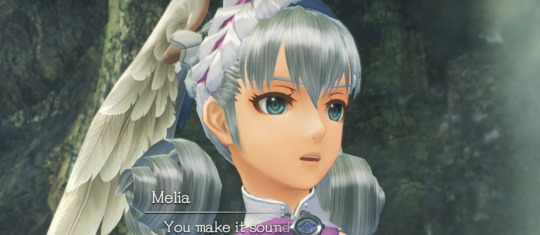
What’s not the same is the music, and before they even directly stated that 90 songs are being remixed/rerecorded, I knew they remastered the music. I have listened to the soundtrack every night for years, I know when it’s different.
And when they say 90, they mean literally every song in the game. The official soundtrack has 91 songs, and “Hope” was cut from the game, so that makes 90 songs redone.
Based on how it sounds, I’m actually thinking these might be live orchestra like Xenoblade 2’s. In Iwata Asks’ interview with ACE+ and the other composers, they talked about needing to pick one program to use as a group instead of multiple composition programs. And after listening to the special live orchestrations of some of the music, I think Xenoblade’s soundtrack was synthesized digitally. I’m not saying that’s bad at all, it’s just one way to make music. But I am thinking they used a real orchestra for DE.
You guys remember my post on how Xenoblade’s official character art were all retouched 3D models? Well, here are some preview pages from the art book that I found off Nintendo of Japan’s website for XCDE. Absolutely gorgeous art in a 250-page art book. We now have weapon designs, concept art of locations, new outfit/armor turnarounds, Scuba Shulk(TM), and new official character art—3D models! Lol.

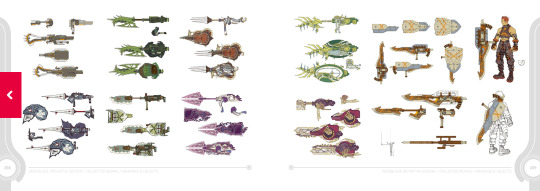

As a note, the Mechonis art on the front of the special edition art book is exactly the high-definition art of the Mechonis in the Monado Archives, and the Mechonis’ texture in the game looks pretty darn close to this art. I think they modeled the remaster/remake Mechonis model off of this art piece, and the same goes for the Bionis’ Monado Archives high-definition art.


Yes, the epilogue, Future Connected. I saved it for last because I genuinely stopped the Direct after the main trailer not realizing there was more.
So I realized the promotional images had more that I didn’t see, so THEN I watched more of the Direct and saw this.
I’m torturing you all.
You get to wait until Part 2.
I’ll be posting next some high-definition images of some in-game locations I pulled from Nintendo of Japan’s website for the game. I felt like a hacker, using Inspecting the Elements in Google to get these. They make great desktop screensavers. I love my grandiose shot of the twin statues of Soltnar and Khatorl.
Honestly, I’m so grateful and thankful Xenoblade Chronicles Definitive Edition is being made.
Part 2: Future Connected (facts and theories) and images of in-game areas from the Japanese site for XCDE.
#xenoblade#xenoblade chronicles#Xenoblade Chronicles Definitive Edition#nintendo switch#I'M SO PSYCHED#And when I say not spoiling I mean the game trailer didn't spoil anything#I probably spoiled something
14 notes
·
View notes
Text
GamePro’s SNES Criterion Collection
Back in 2011, the now-defunct GamePro published a piece including Criterion Collection-style covers for a handful of SNES titles, along with descriptions of the hypothetical bonus materials that would come with such deluxe rereleases. Though the cover images are still floating around online, a bunch of the descriptions are probably lost, including those for games like Street Fighter II, Donkey Kong Country, U.N. Squadron, Desert Strike, and Chrono Trigger.
A few can still be accessed via the Wayback Machine though, so I decided to repost the ones I can still get to:
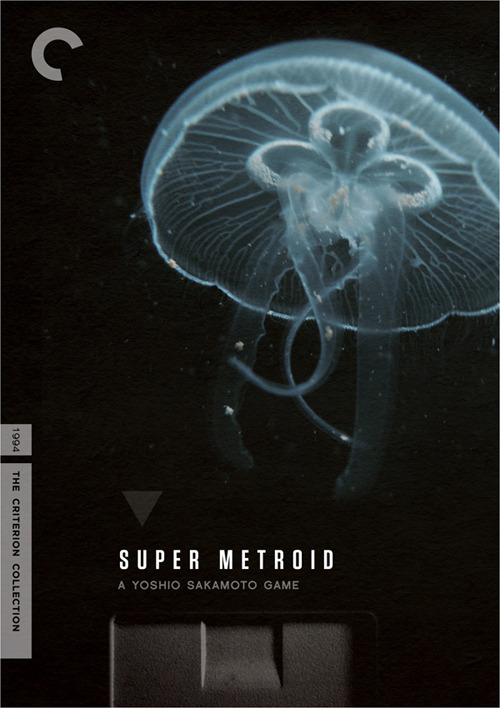
An old enemy brings bounty hunter Samus Aran back to Zebes, where she discovers that the Space Pirate threat is greater than ever -- and thus begins one of the most evocative games ever made. Thanks to its simple but powerful storytelling; outstanding soundtrack; and massive, lonely world, Super Metroid, created by Nintendo's well-known R&D1; team, is a masterpiece of design that has come to represent the Super Nintendo at its pinnacle.
SPECIAL EDITION DOUBLE-DISC SET FEATURES
DISC ONE
All-new 16:9 transfer optimized for high-definition televisions
Video introduction by writer/director Yoshio Sakamoto
Two Interactive Audio Commentaries: one by Yoshio Sakamoto, Satoru Iwata, and Shigeru Miyamoto; and one by producer Makoto Kano
New Leaderboards: Test your sequence-breaking skills against the best speedrunners in the world
DISC TWO
Return to Zebes (2011): A 90-minute feature documentary on the making of the game
From Zebes to the Bottle Ship (2011): A 30 minute documentary about the history of the Metroid franchise
Deep Red: Scenes from the film that helped to inspire Super Metroid
Sequence Breaking: Noted speedrunners offer a guided tour of sequence breaking in Super Metroid
Into Tourian Base: An interactive map of Zebes with developer commentary and notes
Play the complete, original Metroid for the NES
Illustrated production history with rare behind-the-scenes photos, original press kit, and the U.S., European, and Japanese trailers
PLUS: Complete OST featuring original and remastered tracks from Super Metroid

A party of four child prodigies must band together to fend off a mysterious, malevolent alien force in this cult-classic role-playing game, scripted by influential Japanese copywriter and author, Shigesato Itoi. Ness, Paula, Jeff, and Poo embark on a fantastic adventure that spans a quirky, contemporary world, with a charming sense of lighthearted humor that shines through to the engrossing story’s awe-inspiring ending.
SPECIAL EDITION DOUBLE-DISC SET FEATURES
DISC ONE
Fully animated opening and ending cinematics from Studio Ghibli.
In-game commentary from director/producer/writer Shigesato Itoi, designer Akihiko Miura, and composers Keiichi Suzuki and Hirokazu Tanaka.
Live recording of the “Earthbound Orchestral Experience.”
Excerpts from the new translation of Saori Kumi’s Earthbound novelization, read by the author.
DISC TWO
The Man that Fell to Earthbound – Retrospective Q&A; with Shigesato Itoi about Earthbound’s critical and commercial reception.
It Hurts -- documentary feature chronicling the troubled production of Earthbound 64.
Outgrowing Onett - A short film from director Mamoru Hosoda (The Girl Who Leapt Through Time, Summer Wars) that bridges the gap between Earthbound and Mother 3.
Brand new trailer of “Mother 3DS,” the highly anticipated, “definitive” edition of Mother 3.
All-new localization effort overseen by acclaimed director and screenwriter Brad Bird (The Incredibles, The Iron Giant).
Complete HD reimagining of the original Mother.
PLUS: Concept art gallery, and interviews with the game’s development staff.
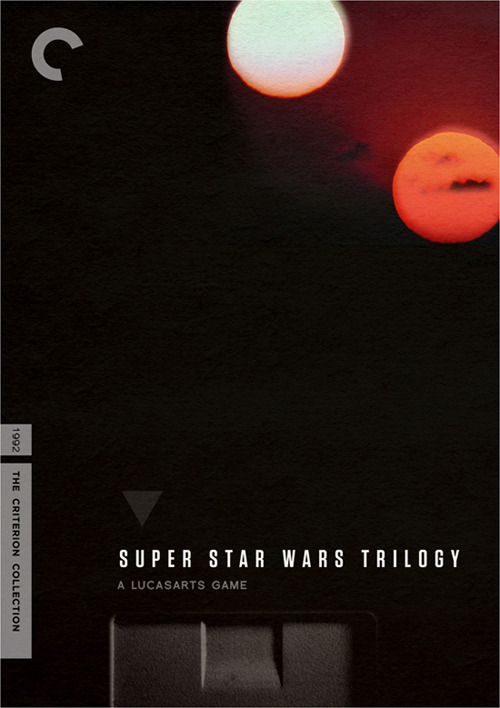
In a galaxy far, far away, join Luke Skywalker, Han Solo, Princess Leia, Chewbacca, and even Wicket the Ewok as they wage intergalactic war against the evil Empire and the sinister Sith lord, Darth Vader. In this ultimate HD edition of Super Star Wars trilogy, you’ll experience the entire saga, including racing a landspeeder through Tatooine’s wastelands in A New Hope, battling colossal AT-ATs storming Hoth’s rebel base in The Empire Strikes Back, flying the Millennium Falcon through the Death Star’s core in Return of the Jedi, and many more memorable adventures from the classic sci-fi trilogy.
SPECIAL EDITION DOUBLE-DISC SET FEATURES DISC ONE
All three Super Nintendo classics in their original form: Super Star Wars, Super Star Wars: The Empire Strikes Back, and Super Star Wars: Return of the Jedi.
Remastered 16-bit visuals and crystal clear audio optimized for high-definition televisions.
New inventory management menu allows you to hang on to your weapons and powerups through all three games.
Save system lets you save your progress at any time.
New beginner-friendly “Apprentice Mode” eases newcomers into some of the most challenging Super NES games ever mad
DISC TWO
Deleted Levels: Two new playable missions previously cut from the games including R2-D2’s battle through Jabba’s palace.
A History of Sculpted Software: A 15-minute documentary chronicling the developer’s daunting task of reenvisioning George Lucas’ epic science-fiction series for the Super Nintendo.
From Giant Scorpions to Frog Dogs: An all-new 10 minute documentary examining the genesis of Super Star Wars trilogy’s most bizarre enemies.
Digital Strategy Guides: Digital versions of the original strategy guides to help you master what are considered some of the toughest video games on the Super NES.

Ladies and gentlemen: Start your engines, and prepare to challenge some of Nintendo’s most famous gaming characters in a high-speed battle of skill, wits...and luck! A huge critical and commercial success, Super Mario Kart is a seminal race-combat game from the 16-bit heyday of the early 90s that is so well loved, it continues to rank highly on “Best Game Ever” lists almost 20 years since its first release. Its key to success is its finely tuned, beautifully balanced multiplayer battle system that feels as fresh and fun as it did nearly two decades ago. Now’s your chance to rediscover the multiplayer magic of one of the best Super Nintendo games in three different forms, including an all-new Director's Cut!
SPECIAL EDITION DOUBLE-DISC SET FEATURES
DISC ONE
Director’s Cut: Featuring all-new polygonal graphics, the characters and courses are completely reimagined for a stunning, cutting-edge visual experience.
Enhanced Edition: A digitally remastered 16-bit version, with 1080p sprite-graphics taken from the original release, and authentic original gameplay
The First Cut: The completely untouched original version of the 1992 Super Nintendo release
Battle On!: Watch as the game’s original creators challenge one another in multiplayer combat and talk about their favorite weapons and characters
The Kart Legacy: A documentary on the legacy of Super Mario Kart, its numerous sequels and ports through the generations, and how it spawned an entirely new genre of racing games.
DISC TWO
Beyond F-Zero. The Making of a Two-player Racer: An in-depth interview with creator Shigeru Miyamoto about Super Mario Kart’s multiplayer design philosophies.
Unlocking Mode 7: Tadashi Sugiyama and Hideki Konno talk about the technical aspects of using Super Nintendo’s Mode 7 to deliver a great gaming experience.
Digitally remastered music by composer Soyo Oka
Bios and gameography of each Super Mario Kart character: Mario, Luigi, Princess Peach, Yoshi, Bowser, Donkey Kong Jr., Koopa Troopa, and Toad.

Cities are living, breathing things -- just as much as the inhabitants that walk their streets -- and nowhere is this more apparent than in Will Wright's masterpiece. Providing one of the earliest examples of free-form emergent gameplay, Sim City for the Super Nintendo is a seminal work, grounded in reality but limited only by the player's imagination.
SPECIAL EDITION DOUBLE-DISC SET FEATURES
DISC ONE
Two editions of the game: The original Super NES classic and SimCity+, a specially optimized widescreen edition for modern high-definition televisions.
Social Play: Connect your cities to those of your friends around the world.
Video introduction by Will Wright and Jeff Braun.
Fully voiced tutorial and advice featuring Nolan North as the voice of Dr. Wright.
DISC TWO
Af Wubbas Do (2011): A 60-minute feature documentary chronicling the history of the entire Sim series, from City through Copter to The Sims.
Urban Canvas (2011): A 30-minute exposé of the radical computer artists who use the SimCity series' landscaping and planning tools to produce works of visual art.
The Full, Uncut Raid on Bungeling Bay for Commodore 64: The game that inspired SimCity's creation.
Interactive gallery of real-life cities modeled in the game.
Original press materials and trailers.
Digital copy of "Street Music," an album featuring music from and inspired by the series.

Years ahead of its time, Actraiser was one of the most loved games released on the Super Nintendo Entertainment System. Genre-bending civilization-building simulation with side-scrolling action, the game didn’t continue as a decades-long franchise like some of its other contemporaries, but it was never forgotten. Stepping into the omnipotent shoes of “The Master” to save the land and its people from the evil Tanzra and his six lieutenants is not only many gamers’ first memory of playing a “god game,” for some it is also their fondest memory from the entire 16-bit era.
SPECIAL EDITION DOUBLE-DISC SET FEATURES
DISC ONE
All-new 16:9 remastered transfer optimized for high-definition televisions
Switch between the original 2D art assets and the all-new polygonal art with the push of a button.
Video introduction by director Masaya Hashimoto and writer Tomoyoshi Miyazaki.
Audio commentary track with the game’s designers.
DISC TWO
“The Creation Story” (2011), a forty-minute short documentary on the development of the game.
“Lightning in a Bottle” (2011), a roundtable discussion with Masaya Hashimoto, Tomoyoshi Miyazaki and Peter Molyneux about ActRaiser’s influence on game development and the “god games” genre.
The complete Yuzo Koshiro soundtrack performed by the Los Angeles Philharmonic Orchestra.
An interactive gallery of over 100 never before seen sketches, concept art, and other design documents.

All that stands between a world’s freedom and its conquest by a ruthless tyrant is the intrepid pilot Fox McCloud and his dauntless friends of the Star Fox Team. Featuring the groundbreaking technology of the Super FX chip, Star Fox brought Nintendo into the world of 3D computer graphics. And flying through the sky and in space in the Arwing starship is perhaps the best way for Nintendo to bring polygons to its consoles.
SPECIAL EDITION DOUBLE-DISC SET FEATURES DISC ONE
Remastered audio and visuals, featuring Dolby Digital EX surround sound and a 16:7, HD presentation. Game’s original 1992 audio and visuals are also on the disc.
Two audio commentaries: One from the game’s executive producer, Hiroshi Yamauchi, and producer, Shigeru Miyamoto, and another with commentary from the point of view of Andross, the game’s villain.
Updated motion-comic version of the original Star Fox comic that ran in Nintendo Power from February 1993 to December 1993.
DISC TWO
“Defenders of Corneria”: a 90-minute documentary on the making of the original Star Fox.
“Fox Through the Ages”: A look at how Fox McCloud and the series has changed since their 1992 inception.
“Arwing Declassified”: A collection of other designs considered and rejected for the iconic Arwing starship.
“The Art of Star Fox”: Images of Fox McCloud, the Star Fox Team, and the memorable worlds from the franchise.
Original promotional ads from Japan, Europe, and North America.
PLUS: The Complete Original soundtrack.
12 notes
·
View notes
Text
Kakashi Asks-Answer
Q: (From @nyxako-writing) “So this is more of a silly question, but since the Narutoverse has everything we have (except for guns) do you think Kakashi would ever be a gamer? And if he played any of the Legend of Zelda games, which would be his favorite? XD”
A: Okay so, here’s the thing.
Nyx has the pleasure (?) of knowing me through Discord, and when I’m not geeking over Kakashi, I’m geeking over the Legend of Zelda games. I owe you a life debt for presenting me with this scenario, Nyx! I’m sitting here happy as a clam with my Beta, my Naruto Official Character Data Book and my LoZ encyclopedias.

While I was taking my own sweet time drafting this answer, the incredibly talented @roonie-doodle made my dreams come true by creating this piece of fanart featuring BOTW Sheikah!Kakashi:

Grab a snack and a tasty beverage and buckle up for ALL the geeking Hima below the cut.
In Boruto, we see the next gen ninjas behaving rather UNninjalike with their handheld gaming devices. Whether that’s allowed under the Shinobi Rules or not, it proves that video games exist in Narutoverse.
As a single dad, Sakumo would totally employ screens to occupy Kakashi so he can catch a nap between missions. It’s my opinion that the members of the Hatake household would not like combat games. Think about it: after a day of working in customer service, would you want to unwind with a game that requires your character to level up at a call center? Coupled with their predisposition to PTSD and I think that’s a great big nope. However, father and son could only play Pong, Asteroids, and Pitfall so many times before Sakumo would see the benefit of spending his ryo on the more sophisticated NES, when it becomes available.
According to me, everyone should love the LoZ series and that includes the knuckleheads of Konoha. Even without my totally biased viewpoint, I think Kakashi would enjoy some, but not all of these fantasy adventure games. After he inserts that first Zelda cartridge into the console, he’d be astonished by the colors and the music. His little masked mouth would water at the ability to go up and down, left and right.
And when he enters that fantastic cave where the wisest npc is waiting with a sword and the warning, “It’s dangerous to go alone! Take this,” Kid!Kakashi would be hooked.
It’s not just the gameplay that has him running back to Zelda after killer kindergarten lets out for the day, though. I think that the first time Kakashi realizes he could’ve taken the shorter route of up, right, up, right, right, right, right, right, up, left, up, to the second dungeon (instead of his initial path of up, right, up, up, up, up, right, right, right, right, right, down, down, left, up), he’d grab his ninja crayons and draw a map of the whole darn overworld. Sakumo would totally put that shit up on the fridge too.
Then, then, after Kakashi has smashed through every breakable wall, moved every block, and beaten the OG Ganon, there’s a second effing quest waiting for him (and what a beast it is). Sakumo would be able to put the first map in his son’s baby book then because it’s basically useless for the second playthrough, and Kakashi’s meticulous approach to beating the game would begin anew.
Time to grab a tissue because this is where things get angsty. As we all know, my poor octorok-squishing bean has a very short childhood. While I’m sure that he would’ve loved the hell out of the first Zelda game, he is much too busy being a child soldier in the Third Shinobi War to play The Adventure of Link. While Nintendo offers new consoles and LoZ games to go with them, Dungeon Boss-Kishi plunges Kakashi into darkness with neither a red candle nor a blue one to help him find his way out. Between dodging Danzo and loathing himself, I can’t help but think that it’s impossible for this ANBU assassin to find time to play A Link to the Past or Link’s Awakening. Sob.
However, the Sun’s Song is unlocked and the clouds part for the early days of Team Seven. I can totally imagine Kakashi spying on his cute little genin (while he makes them wait for him) and overhears them discussing one of the best games in the LoZ series, Ocarina of Time. After all the lunches Yams has bought for him, Kakashi decides he can afford to splurge on an N64, and he attempts to recapture some of that Zelda magic from his youth.
This game does not disappoint Kakashi, either.
Like everyone, he’d consider muting the TV way before Link had a chance to verily demonstrate his courage because of Navi’s constant interruptions. However, I think after dealing with another talkative bright ball of a boy as his student, Kakashi is willing to put up with Navi out of respect for the late Great Deku Tree’s wishes.
Honestly, I think Kakashi could relate to this version of the Hero of Time. The poor kid doesn’t quite fit in with the others around him, he’s orphaned, has the expectation of saving the world thrust upon his little kid shoulders, then before he knows it, he’s all grown up and the world around him is even more dangerous than it was when he started.
Even though a map is provided in this game, I think Kakashi might still keep notes of every odd thing he encounters as he thoroughly explores 3D Hyrule (boulders, different colored trees and wide spaces that LoZ geeks know are suspicious). He’d be the kind of gamer that focuses on completing the game-not just beating it-making OoT the right game at the right time for him. He’d plant every bean (and drop bugs on the sprouts), get every weapon upgrade, collect every piece of heart and every gold skulltula. He’d be intrigued by the owner of the Happy Mask Shop (as well as Impa, the Skull Kid, that shady Poe Collector fellow, and Kaepora Gaebora), and he’d make sure that Link models each mask for the Deku Scrubs in their hidden grotto. The Water Temple would’ve driven him just as crazy as it drove the rest of us LoZ freaks when he finds that he’s one key short or didn’t move that one block before adjusting the water levels, but it’s all forgiven when he fights Dark Link.
Kakashi would use fishing as an excuse for being late to meet with Team Seven and it wouldn’t be a lie. Naruto, Sasuke and Sakura would catch on to the truth when their sensei starts absentmindedly humming the OoT soundtrack (the Gerudo Valley theme is his favorite) because everyone that’s played the game is guilty of it.
By the time Kakashi realizes that it’s impossible to beat the Running Man (even with the Pegasus Boots) in that damn race to Kokiri Forest no matter how many times and how many different ways he plays OoT, Majora’s Mask has dropped.
The alternate world of Termina serves as the perfect distraction from Sasuke’s obsession with revenge, and the beginning of the end of Team Seven. Kakashi would be quick to appreciate this game from the beginning; chasing after that weird Skull Kid from OoT, which leads Link to encounter the Happy Mask Shop owner who, right off the bat, starts to prove what a creepy creep he really is.
It should be obvious without my listing all of the reasons as to why Kakashi would love this game. The world is gorgeous, the story is mysterious, the dungeons and bosses are challenging, the Garos, the MASKS fer chrissakes, and the side quests (OMG, the side quests) are an LoZ completionist player’s dream.
If you still need proof that Majora’s Mask is among his favorite games, I offer Kakashi’s boldest move as the Roku-blow-up-the-moon-daime. Fight me.
I’ve kept to the LoZ games that have been released for home consoles because I think Kakashi would avoid the handheld devices. He doesn’t need to have his gaming habit blow his cover while out on missions. He has his trusty, tattered copies of Icha-Icha books and those are plenty to keep him occupied and entertained during downtime around the campfire.
At any rate, at this stage in the Naruto series, the main hero is off training with Jiraiya and the Leaf is short on shinobi to run missions, so Kakashi wouldn’t have much time to indulge his love of LoZ games anyway. He’s definitely invested in the series by now and curious about new installments to it. He would be aware of the release of The Wind Waker, but I think his initial impression of that game would be that it appears cartoonish, and may not be enough to spark his interest in the game at the time.
However, I’m certain that the next LoZ home console release would have those tantalizing fingers of his twitching to play again. I think there’s a lot about Twilight Princess that would catch his attention. The overall dark tone of the game would remind him of Majora’s Mask, new characters and enemies… The familiar LoZ story branches off into new territory and I bet that would have him keen to explore it.
But then he starts to play it.
Twilight Princess starts off so damn slow and Kakashi is so damn busy at this point in the series that I think he saves and quits and isn’t in a rush to return to the game. He’s got a Kazekage to rescue and a Kyūbi to protect; he doesn’t have time to herd oxen and chase cradle-stealing monkeys.
After the power of friendship saves the day and Gai carries Kakashi home, the copy-nin is bedridden and picks up the game again out of boredom. His interest in it is rekindled when he meets with the Twilight Emissaries and is turned into a wolf. Midna entertains him, definitely.
Honestly, I think Kakashi would have a love/hate relationship with Twilight Princess. My headcanon is that he would enjoy another opportunity to explore the world of LoZ, but this game doesn’t present the kind of satisfying overworld journey as other games did. He would be impressed by a few of the characters, but scratch his head at most of the others. He’d have a greater appreciation of the enemies, dungeons, the Ancient Hero, the Cave of Ordeals and especially, the overall story. However, I’m convinced that Kakashi is a completionist and anyone that challenges themselves to complete Twilight Princess knows the unbearable pain of Rollgoal. Ugh.
After Kakashi finishes this game he doesn’t sell it, but he doesn’t replay it often and never through to completion again. He’s satisfied that the Kingdom of Hyrule is safe as long as Malo exists within it.
At this point in Naruto’s flawed timeline, things are coming to a boil. Kakashi faces off in his own boss fight against Pain and Konoha suffers the same fate as Kakariko. My favorite ninja dork falls in battle (and I rage-quit the series for a while), but Kishi releases a bottled fairy and Kakashi is revived to fight in another shinobi war, become the Rokudaime, and play more LoZ games.
Or so he hoped.
Being Hokage comes with more paperwork than any elite shinobi could complete in a lifetime. The position also comes with a pay raise (as I imagine), so I see Kakashi parting with some of his savings to give the gift of a Wii and Skyward Sword to his best buddy, Gai.
I think that this is an LoZ game that Kakashi would be content to occasionally watch his eternal rival play, rather than play himself. Lord Sixth would love the story, would love the presentation that this game is the beginning of LoZ lore. He would also love that he is watching rather than playing when Gai deals with the frustration of syncing and re-syncing the controllers when he flies his loftwing, or swings the Master Sword. The only time I think Kakashi would grab the controllers for this game would be to take a crack at Koloktos. I also think that would be the only break he’d get to sneak in some LoZ fun while he’s Hokage.
Of course, this means Maito would become a fan of the LoZ games and he would approach them with the same gusto he applies to everything in his life. Gai would play through the back catalog, training for when Kakashi retires and becomes available to speed-run playthrough challenges.
Gai would be the friend that convinces Kakashi that he must play The Wind Waker and distracts his rival from the eternal sailing by explaining why A Link to the Past might be the most important game of the LoZ series. Now that Kakashi has reached a point in his life that offers him time for leisure, he plays through it as well as other games in the series that he had missed out on. Besides adding A Link to the Past to his list of favorites, it would otherwise remain unaltered at this point: Zelda, OoT, and Majora’s Mask.
By the time Kakashi knows the significance of the yellow band in the various caps worn by the Hero of Time, Breath of the Wild is released and his list of favorite LoZ games grows again.
There is just so much about this game that would appeal to Kakashi. The sheer size of the overworld (I’ve read it’s 360 square kilometers) and the fact that he can explore the whole thing would be this ninja dork’s dream come true. He can progress through the game however he wants to. He’d buy that Sheikah set right away, and find Majora’s Mask as soon as that DLC dropped and roam the world to his heart’s content.
Kakashi wouldn’t be bothered by the odd trophies this game offers for completing it, because as a completionist player, he understands that completing it is its own reward. His alter-ego Sukea would love taking photos both for the compendium and for the sake of fun. Kakashi loves to infiltrate, gather information, solve puzzles, and form plans and BOTW offers all of that in spades.
He’d restart the game so many times just to try out different strategies. The first time Kakashi leaps off of Mount Lanayru, sputters out of stamina and lands on a buck that charges straight for the blue lynel in Naydra’s Snowfield (this totally happened to me btw), he’d realize he should’ve been trading those spirit orbs for stamina vessels instead of only heart containers; resulting in his first restart. The second restart would come after Gai shows off his spiffy expand-a-band-banded inventory and this time, Kakashi would plow through the Great Plateau so he could recover that pair of priceless maracas. Countless other restarts occur as Kakashi experiments with which and how many towers he should attempt to overtake before he finally makes his way to Impa.
With every restart, he learns something new about BOTW and enjoys it more. He commits locations to memory (at least 148 for the towers, shrines and captured memories). He rushes to gather the essential 441 Korok seeds in each new playthrough (he might shed a tear when he finally becomes a member of the 900 club-I know I did). He figures out how to cheat on Eventide Island. He learns that even though he could launch Link across Hyrule with Magnesis and Stasis doesn’t mean he should. He looks forward to every Blood Moon, if only to cook as many hearty durians, mighty bananas, and endura carrots as he can between 11:30 and midnight in-game time. He realizes that his greatest enemy in all of Hyrule is the weather. When the Champion’s Ballad is available for download, his excitement for playing the game begins all over again.
I’ve stated several times that I’m convinced that Kakashi would be a completionist player and out of all the games, the latest LoZ is a pleasure to complete (despite what some YouTube gamers may say). In addition, BOTW came out during a period in Kakashi’s life when he could afford to spend significant time playing it.
And this finally brings me to the answer to your question. Breath of the Wild would be Kakashi’s favorite LoZ game, hands down. He would love this game so much and would enjoy playing it so often, that I think he had a Nintendo Switch stashed in the fanny pack he rocked during the Steam Ninja Scrolls arc.
XOXO
#kakashi asks#ohayohimawari answer#Kakashi#Kakashi Hatake#roonie-doodle#naruto fanart#sheikah kakashi#loz#i had so much fun answering this
94 notes
·
View notes
Text
A Proper Postmortem
Maybe?! Heck if I know how to actually format a good post but let’s try. As game development went on for almost four years, this is probably gonna be long... and also give away basically the whole game oops! Read on with caution.

Sometime around July 2014, a month after the initial release of my first game, my room was being remodeled and I was stuck with nothing for free time but a garbage laptop I could do anything on, an old flip phone, my sketchbook, and my 3DS. So beyond playing an obscene amount of Animal Crossing and Tomodachi Life, I at some point went “hey, what if I made a second game starring the kids.” So I started trying to plan it out! And it went
absolutely nowhere that I intended it to go!!!
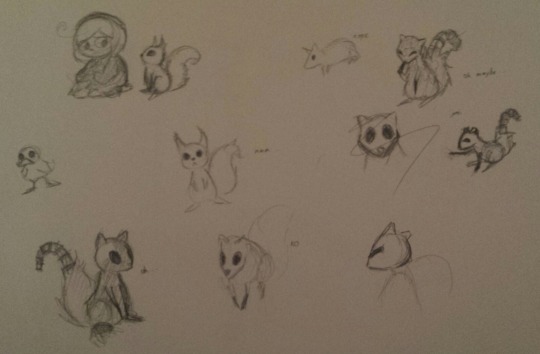
For instance, this is the very first page of sketches. This squirrel was supposed to be really important. It’s not. I don’t even KNOW what’s up with that duck.
A thing I like to think about before I set off making any of the story, assets, or scripts for my games tend to be themes and motifs. And I kept circling back to a very important, very personal “theme.” Without using the internet at large as my therapy couch, I was emotionally abused and taken advantage of multiple times in my life and it greatly impacts how I interact with people to this very day, as you’d expect events of such a degree would. Particularly, I kept thinking that the RPG Maker fan crowd tends to skew young and be in the teenage range and at ages 14-16, I could’ve used something to help.
Of course, my entire thought process isn’t necessarily one of charity and selflessness. It was also a way of me expressing what I’d dealt with in ways I’ve only ever communicated with my friends who were also victims of the same circumstances, the closest I would let myself come to personal stories and retellings with a cover of plastic children and wild adventures. It was also in some ways a way of me verifying to myself that something ongoing was, in fact, bananas and should not have been happening, but that might be another story for another time.
As you can probably guess, Haze and Seal came into the picture since I needed to make two characters who would have this struggle. A lot of decisions came about because of my personal experience. They’re 15/16 because I was at the time of the incidents that primarily inspired me to make this game. They’re both nonbinary because I am. They love anime because I did (and do...?!) One of their friends is even directly modeled off how one of my friends looked in high school. To that degree, I guess someone, somewhere can call them self inserts. But they’re also not, since I didn’t want to just do a personal retelling with fictional characters. I’d just write a memoir or something at that point.
Haze’s design came first, and then Seal’s was sort of made as a foil to them. Haze’s “colors” are pink, black, grey, and red. Seal’s are teal and light purple... and also black. Haze had a rabbit motif (which got toned down as I went on), Seal had an owl motif (which is now just a single mention in their list of likes...), etc.
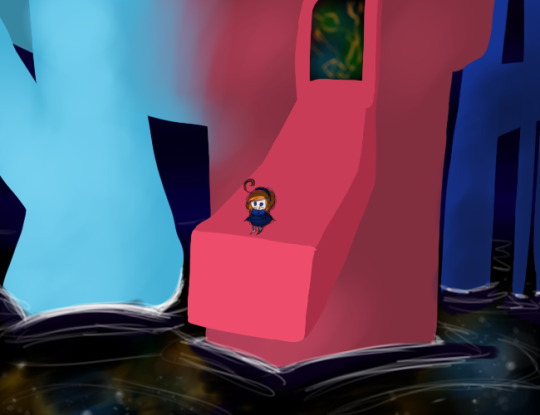
Though in the beginning, the story was entirely different. Initially, everything took place in the neon-ish areas with black sky and reflective, celestial water (that I, very eloquently, call “spacewater”). The idea was that Haze and Seal were beings from another dimension and that their “fighting” was causing a rip in the universe that the kids stumbled into and therefore got wrapped up in this mess. I had an entire script written and started making assets and when I went to sum up the game’s plot in a neat paragraph, I realized... I hated it!!!
So I chucked all I had done by that point writing-wise and started again.
In fact, I rewrote a lot. After the first it was mostly small tweaks and adjustments, but the biggest ones (and the ones that still present a challenge to me!) usually involved trying to make Seal feel like a believable character. I had shown an early draft to someone who said that Seal felt too much like trying to get back at someone, so I scrapped a ton of their lines and tried again. I still worry whether or not they come across too Strawman-y, but I’ve done the best I can and whatever criticism people have can apply to my next writing attempts. It’s very hard to separate yourself from subject matter you feel really personally attached to. I don’t want to write them in a way that you immediately hate them, or hate me for writing such a blatant “villain” character, but in a way that you can formulate your own thoughts. That said, though, I am violently allergic to people who call Seal a “tsundere,” even in jest. So I guess I want people to have their own thoughts as long as it’s not that specific one...! (;;;;)
You may be thinking “heck, this is a lot of paragraphs in and you haven’t even brought up gameplay thoughts” and yes... that’s very true. Shamefully, for a game where I thought “I should definitely, absolutely focus more on making it a Fun Game than a walking visual novel” I might’ve actually dropped the ball in that area. I’d like to think I was more adventurous than I had been with my first game. Some parts do kind of fall into the “walk to the next cutscene, find a key to unlock the next cutscene” pit, but I did put effort into figuring out what I could do with RMXP. My obligatory “please don’t use this engine here, people thinking of using RPG Maker” statements here. In the final product, though they’re very simple, I’m most proud of the chalkboard puzzle and the paint sorting puzzle.
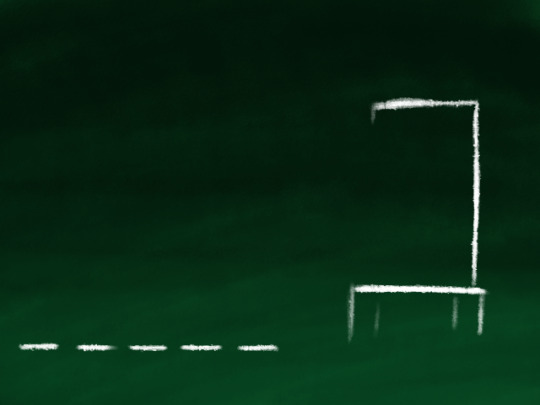
Even if, y’know... I somehow neglected to include the letter “k”
Speaking of, I’m not sure if this is a general RPG Maker thing, a “man I hate RMXP” thing, or a “meaka cannot gamemake” thing, but I had several event/puzzles just up and quit on me a few times. Like they would work fine for months and months, but one day I’d go to them and just nope, suddenly they’re not working, sorry. Copy+pasting the event to a new map wouldn’t work, so I’d have to manually redo the event. One of them was the chalkboard puzzle. The other was the sliding puzzle when Tony is by herself. Which I’m also aware slows the game down a ton, but I have legitimately no idea how to fix that... I tried and I could never get to to not lag like crazy.
Like I said, I started in July 2014. I’d shipped the game off to my beta testers in March 2018. A vast majority of that time was spent creating the visual assets since everything you see in the game is custom. All the sprites, all the tilesets, every little pixel of it. All me! Needless to say... it was very exhausting and very time consuming. I grossly underestimated how much time I thought it’d take. I never accounted for the very real possibility of burnout, which is incredibly silly considering I was making something entirely by myself that was also an occasionally difficult subject matter...! There were quite a few weeks where I touched nothing because I couldn’t bring myself to and even a few times where I just considered deleting everything and cancelling the project. I knew I’d be mad at myself if I quit, especially as I got later into production, so I just tried my best to make sure I didn’t turn it into a huge chore. Obviously, there were parts that were more tedious than others, but this game really is a very large labor of love that I put a lot of my heart into.
Part of that time is also a little bit of indecision. Did you know I went through 3 possible title screens? I sure did! I’ve also publicly posted about redoing both Haze and Seal’s bust sprites before. I almost redid all of the kids’, too, but I didn’t wanna get caught in the loop of remaking everything, so I opted to just leave them as they are. Most of them don’t bug me as much. M...most of them!

I’m hopping back on the Story train since obviously that was my main focus, but the decision to have Seal sort of “reveal” their true nature (or at least have a jealousy-related anger burst) to Octavio as an animated cutscene was one I’d decided pretty early. Which is also why, unsurprisingly, I was debating getting voice actors for a hot minute. But I wouldn’t have used it anywhere else in the game, so I opted not to. I also wanted to keep the file size low, but that wound up not happening so much, h-haha... For someone who uses the only engine without native support for videos, I sure do like making animated cutscenes, huh.
Anyway. This scene originally bridged Octavio’s section of the game to Pablo’s, which would’ve been (for some reason) in an abandoned hospital. But that didn’t pan out because it didn’t fit what I wanted the game to be and also by switching the order of the two, it builds up more tension(?) on the kind of character you expect Seal to be. I hope their very first “fuck off, maybe” took someone out there by surprise!
This also was the point when I decided I wanted to commission an original soundtrack, since nothing quite got across what I wanted at the time. Which is when I put out my silly ad post and somehow managed to get the amazing ProjectTrinity to compose for me...! I’m still amazed by the sheer quality of music he made for my little RPGMaker game.
Having the teen characters curse was also something I waffled on for a bit. Clearly, I dwell on the important things as a writer. I wanted it to contrast the cutesy, kidlike way the siblings talk and also the sort of squeaky-clean image the witches (particularly Seal) present to the kids by contrasting how they talk to each other, most importantly how Seal talks to Haze and their other friends. I did have the same issue with the Mother in my first game, but I opted to not have her curse at all either since she’s childish in her own way, too. But that’s not for THIS game’s postmortem, get otta here!!!
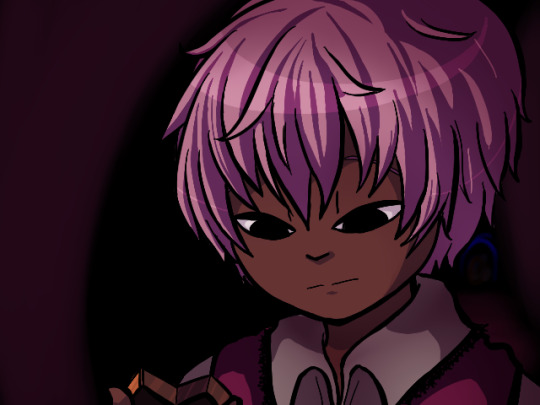
I also very much was set on a “battle” with words being the final event of the game. Though I had a hard time imagining what that would be initially, but eventually arrived at a sort of fake battle system that was introduced in the mine. The setting for this battle changed with time (everywhere from the park to the academy and in between) was considered...! The dirty secret is that while I did like the decision to make it take place in the voids between worlds, I also sort of did not want to draw the staircase in the witch academy. Originally, the kids would’ve also helped Haze “reach” Seal (who was putting actual obstacles in the way), but I guess in my own way, I wanted to give Haze the ability to confront Seal on their own, one-on-one. Or something like that...! I also didn’t want to add too much needless backtracking.
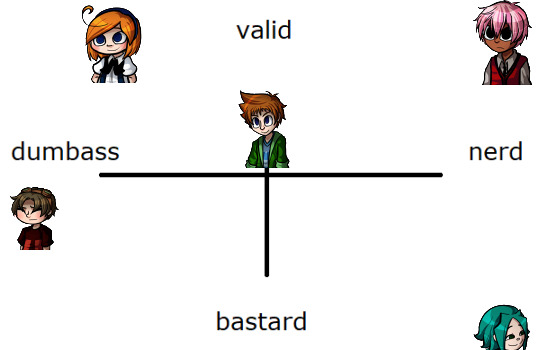
I’m... unsure what other point I really want to make, so I guess I’ll end this here unless anyone has anything in particular that interests them they’d want me to answer!
All in all, this game means a lot to me and took a chunk of my life to make and I really hope it’s able to reach at least one person who might need it, even if it’s only a little.
To all of you who gave it a try, thank you, truly, from the bottom of my heart.
A shameless link to the game: [itch.io] & [RMN]
17 notes
·
View notes
Text
A Somewhat Comprehensive List of Good Old-School FPS Games, Where To Get Them, & How To Get Them Working
I love old FPS games. The action is fast, the levels are explorable, the guns are powerful. Whether you’re tired of modern FPS games or just waiting for some new hotness to come out, there’s a lot of these old games you can play! This list will cover a lot of the old classics and how to get them running on modern hardware (assuming you’re on Windows. Some of these work on Mac/Linux though).
Of course, what defines an “old-school” game from something more recent? Well the way I see it, there are FPS games before Halo, and FPS games after Halo. Halo was such a landmark game that it shifted the entire genre, hell even the entire video game industry. So I’m going to keep this list to pre-2001 games for the most part.
STUFF TO KNOW
Before going into this wholesale, I need to say a couple of things. These game are old. They are most likely not going to work out of the box and will need some tweaking on your part. Most of the non-3D games on Steam and GOG come with DOSBox wrappers. This can be fine for some games, but often times fans have created patches and their own engines/source ports for these games that work better than DOSBox emulation.
PC Gaming Wiki is an invaluable resource when it comes to finding patches and fixes to common problems. I will also point out any fan patches or source ports for the games as I go. On Steam, the curator page Sector Effectors has brief overviews on the functionality of games so you know what you might need before you buy.
A lot of games on Steam and GOG come in bundles that have the entire series in one at a markdown price, so it’s usually cheaper to just buy an entire series than each individual game. I can link to bundles on Steam but not on GOG; those bundles will be on the sidebar underneath the button to buy the game. In the case of games (like Doom on Steam), you have to buy the bundle to get the mission packs, whereas stuff like this is typically included with the game already on GOG.
Make sure you check through the options menu of each game and make sure everything’s set up to your liking, whether it’s video options or your actual controls. The default settings for this kind of stuff in these games are tend to be really weird and outdated, so it’s something you need to check every single time.
Most if not all of these games include various difficulty modes, so whether you’re a badass coolguy like me or someone fairly new to PC shooter games, you’ll be able to play these games.
id SOFTWARE
While they didn’t invent first-person shooter games, it’s undeniable that id Software made the genre as popular as it is today with the games they made.
WOLFENSTEIN (1992/1993/2001)
Wolfenstein was originally an adventure game for the Apple II, but the boys at id wanted to put their own spin on it. What we got was intensely fast Nazi slaughtering action, chock full of gore to spill and gold to swipe. You play as B.J. Blazkowicz, a POW hellbent on escaping Castle Wolfenstein and blasting any Nazi who gets in your way.

Wolfenstein 3D - GOG / Steam Wolfenstein 3D: Spear of Destiny - GOG / Steam Return to Castle Wolfenstein - GOG / Steam Steam Bundle
Wolf3D has a source port called ECWolf, which natively supports most popular OS’s, has widescreen support, and adds an auto-map feature which is immensely helpful for getting through the maze-like levels. At full speed, Wolf3D might make you motion sick, just a word of warning.
Return to Castle Wolfenstein has a 1.42d fanpatch (second from bottom) that adds proper widescreen support. This game has some weird difficulty spikes. Grey Matter Studios, the team that made RtCW, were later absorbed into Treyarch, who later went on to make Call of Duty: World at War and most of the other good CoD games.
Call Apogee, Say “Aardwolf”!
DOOM (1993/1994/1996)
This just might be the best game ever made, though I may be a little biased. Doom was a landmark title in the video game industry, to the point that FPS games were all called “Doom clones” for a while. The last alive in your squad of space marines, it’s you versus the legions of Hell as they take over Mars and invade Earth. Try to make it out alive!
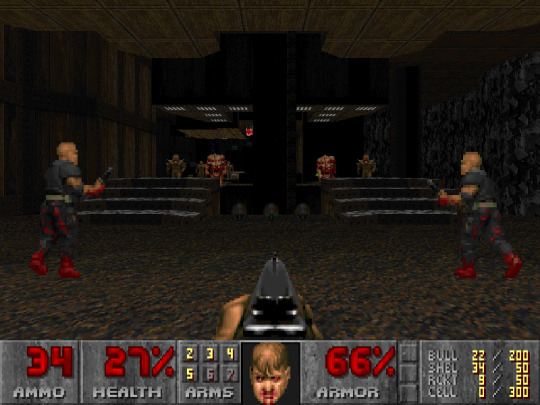
Ultimate Doom - GOG / Steam Doom II: Hell on Earth - GOG / Steam Final Doom - GOG / Steam Steam Bundle (includes Master Levels for Doom II)
Doom has a huge number of source ports, but the most notable ones as of right now (in my opinion) are GZDoom (modern features + mod support), prboom+ (vanilla-style with modern features), and Chocolate Doom (vanilla-accurate). There’s many more though, which I’ve written about extensively here. Disregard Doom 3: BFG Edition, it edits the base data files and makes them incompatible with a lot of custom content.
If you play with a gameplay mod before you’ve beaten the games, I’ll slap you.
Eat leaden death, demon.
QUAKE (1996/1997/1999)
Wolf3D and Doom were pioneers for their own reasons, and Quake’s claim to fame was its fast 3D graphics, full use of the mouse to look up, down, and all around, and intense deathmatch multiplayer. Whether you’re battling it out with Lovecraftian monsters in Gothic castles, waging war against the alien Strogg, or simply blasting opponents in the Arena Eternal, there’s intense action to be had.

Quake - GOG / Steam Quake II - GOG / Steam Quake III Arena - GOG / Steam Steam Bundle
Quake 1 has a few notable source ports. For singleplayer, Quakespasm (John Romero approved!) and Darkplaces (not updated anymore but still works great) are the go-to. I don’t really play Q1 multiplayer so I can’t recommend anything on that end. This Steam guide has some good info on Quake source ports regardless.
Another thing of note with Q1 is that the Steam version does not come with the CD audio. Short of putting a Quake disc in your computer to get that CD audio, you can download this ZIP file I put together. This page has more info about the Quake 1 soundtrack. The GOG version comes with the CD audio, but in the format of a disk image, which can be a pain to get working.
Quake II has an unofficial 3.24 patch (third from bottom) as well as source ports like Yamagi and kmquake2 (top one). Q2 also has the same problem Q1 has, in that the Steam version doesn’t have the rockin’ CD soundtrack. I put together a download for the Quake 2 soundtrack here.
Quake III Arena should just work out of install, though on Steam you might need to disable Steam Overlay as it can screw up the visuals. Outside of that though, there’s a 1.32e fanpatch and the ioquake3 source port. Unlike the previous two games, Q3A is primarily a multiplayer game, though it does have a botmatch campaign that’s fairly fun. The music should work in this one.
Shub-Niggurath awaits you...
RAVEN SOFTWARE
For a while, Raven were kind of a sister studio to id. A lot of Raven’s early games are on id Software game engines. Luckily, this means some of these games can work on source ports for the games listed above!
HERETIC & HEXEN (1994/1995/1997)
Heretic and Hexen run on the Doom engine, and actually added features that Doom originally didn’t have, like being able to look up and down, having an inventory system, having a class system, and being able to jump. Hexen itself plays fairly different from Doom, with much more focus on exploration, puzzle solving, and melee combat, with the ability to backtrack between levels.

Heretic: Shadow of the Serpent Riders - Steam HeXen: Beyond Heretic - Steam HeXen II - Steam Steam Bundle
Being Doom engine games, Heretic/Hexen can be played using source ports like GZDoom and Chocolate Doom with little to no extra hassle. Hexen actually has a CD soundtrack much like Quake, but without a CD you get the MIDI versions of the music instead, which is fine by me since the MIDI tracks are great. If you want the CD music, you can run this WAD when you run Hexen. Check my Doom guide for info on how to do that.
The version of Hexen: Deathkings of the Dark Citadel on Steam is actually the original buggy version with no music. Download this version of it instead for working music.
Hexen II uses the Quake 1 engine, but has it’s own source port called Hammer of Thyrion. Unfortunately, like Quake 1, the Steam version does not include the CD audio. You can download the soundtrack here. Hexen II on Steam also does not include the Portal of Praevus mission pack; you can download that here.
There is actually a Heretic II but it’s third-person and not sold on digital stores due to licensing issues. It’s okay, and more of an early look at a much bigger game Raven Software would make four years later.
Evil grows darkest in the shadow.
APOGEE SOFTWARE/3D REALMS
Apogee was both a developer and publisher for PC games, popularizing the “shareware” model of distribution where a sizable portion of the game would be put out for free, and people could pay for the rest of the game. Wolf3D was actually published under Apogee, but id went solo when they made Doom. Regardless, they made some very notable FPS games.
RISE OF THE TRIAD (1994)
Made on a heavily modified Wolf3D engine, Rise of the Triad was made after Tom Hall left id since Doom’s development went in a direction he wasn’t interested in. It’s much less technically impressive than Doom, though you can choose one of five characters to play as, as well as look up and down and even bounce off of bounce pads.
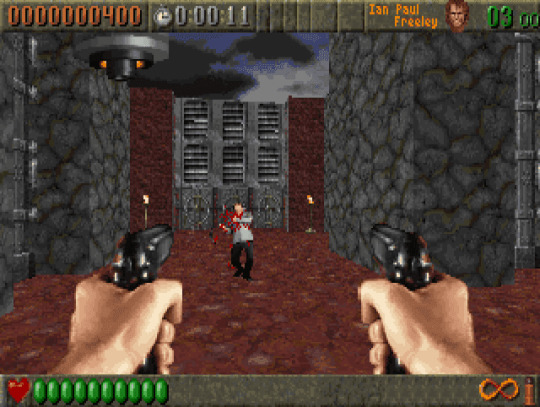
Rise of the Triad: Dark War - GOG / Steam
There is one RotT source port called WinRott (and a more modern version called WinRottAPI). However, it has numerous problems and frequently crashes, making the standard DOSBox version you get with GOG and Steam the more appealing option.
Ludicrous gibs!
DUKE NUKEM 3D (1996)
The first of the Big Build Engine Three, Duke Nukem 3D is the third game in the series, the previous two being sidescrolling shooters. Alien bastards have invaded Earth once again, and Duke Nukem takes it upon himself to blast their asses out of the galaxy, cracking one-liners along the way.

Duke Nukem 3D: 20th Anniversary World Tour - Steam
Atomic Edition is the original “all-in-one” package that includes bonus campaigns which was sold on GOG, and Megaton Edition was a modern rerelease of Atomic Edition on Steam. However, these versions of the game were ripped off of digital storefronts due to Gearbox Software acquiring the Duke IP. The only version of Duke3D to buy right now on digital stores is World Tour. It does not include the original bonus campaigns, but it has an all-new 5th episode where Duke Nukem says “Bazinga”.
Honestly, just have Atomic Edition. This is the version I had before it was taken off GOG. I don’t care. Don’t give Randy Pitchford your money.
The most notable Duke3D source port is eduke32, which adds a lot of modern bells and whistles as well as some fancy new visuals. I’m not sure it’s compatible with World Tour though.
Those alien bastards are gonna pay for shooting up my ride!
SHADOW WARRIOR (1997)
The second big Build Engine game, Shadow Warrior is fairly similar to Duke3D, albeit with a (slightly racially insensitive) Asian theme. You play as Lo Wang, chopping and blasting your way through demons and monsters to stop a corporate overlord from taking over Japan, cracking bad puns along the way.

Shadow Warrior Classic (1997) - GOG / Steam (free!) Shadow Warrior Redux - GOG / Steam
The Classic version of Shadow Warrior is just the original game running in DOSBox. It works pretty well, and for the low price of free it’s worth a play! The Redux version is essentially an official source port, like what Megaton Edition was with Duke3D. It does cost money, but it runs great.
There were a couple of source ports, but the Redux version basically invalidates them.
Who want some Wang??
BLOOD (1997)
The third big Build Engine game. Blood was made by Monolith, more well known these days for F.E.A.R. and Shadow of Mordor. Blood’s a bit of a weird one compared to Duke and Shadow Warrior; its setting is ambiguous and your main melee weapon of choice is a pitchfork. Caleb is an undead gunslinger who’s on a revenge quest, slaughtering cultists and monsters along the way while cracking snide comments.

Blood: One Whole Unit Blood - GOG / Steam
Blood is in a weird situation, where it likely would have had a rerelease similar to Duke3D Megaton or Shadow Warrior Redux, but Atari has a stranglehold on the rights and refuses to do anything with it, even release the source code.
Despite that, Blood does have a couple of source ports of sorts, the standout being BloodGDX. It’s a bizarre reverse-engineered piece of work that runs in Java, but it’s probably the most accurate version of Blood you can play besides the DOSBox version. On the downside, it doesn’t display the pre-rendered cutscenes. The alternative is BloodCM, which is based on eduke32.
There is a Blood II but it’s poopy.
I live... again!
BUNGIE
A lot of people forget Bungie made games before Halo existed. This is because most of the games they made before Halo were for the Macintosh. While Doom dominated the IBM PC market, Bungie decided to carve out a niche on a competing platform, and it worked.
MARATHON (1994/1995/1996)
The guys at Bungie thought Wolf3D and Doom were pretty cool, and they wanted to put their own spin on it. The pace is a bit slower than it’s contemporaries, but Marathon’s focus is instead on exploration and story, which is told through computer terminals. Aliens attack your colony ship, and the onboard AI start to go a little haywire. It’s up to you, a lone security officer, to beat back the Pfhor and prevent Durandal from... oh never mind, there he goes.

Marathon - Free Download Marathon 2: Durandal - Free Download Marathon Infinity - Free Download
The Marathon Trilogy in it’s entirety was put up for free by Bungie, source code and all. The main source port for it is Aleph One. It should just work after install, though you might need to fiddle with the in-game options to get it to how you want it.
All three games come with hi-res texture packs that are based on the Xbox Live Arcade version of Marathon 2, and they kinda don’t look so good sometimes. You can turn them off in the Plugins menu under Environment options to get the authentic aesthetics. The Field of View of the Marathon games is a little low by default, but you can copypaste a script from the PC Gaming Wiki page to remedy that. I played with 100 FOV personally.
Make liberal use of your automap, but conservative use of your ammo. You can only save at designated save stations. Marathon 1 has background music but the other two games don’t. Marathon Infinity’s plot includes timeline hopping. Have fun!
Frog blast the vent core!
EPIC MEGAGAMES & DIGITAL EXTREMES
Before Fortnite, before Warframe, before Gears of War, there was Unreal. Epic Games is most known for the Unreal Engine these days, but there’s a game series behind that name, and it used to be Quake’s biggest competitor.
UNREAL (1998/1999)
Like most games here, Unreal was made to be a technical showcase for the engine it’s running on. This is important because visual fidelity was pretty much the game’s main selling point, and it worked. People were really impressed with how it looked at the time. You play as a escaped convict from a prison ship that crash-landed on a mysterious alien planet, simply trying to find a way to escape.
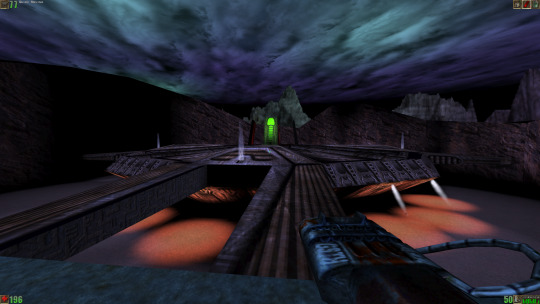
Unreal Gold - GOG / Steam Unreal Tournament GOTY - GOG / Steam Steam Bundle (includes later Unreal games)
These games should just work out of the box, but you can install the Oldunreal fanpatch to make them more compatible with modern systems and resolutions. Make sure you download the one for Unreal Gold, otherwise it won’t let you play the expansion. Unreal Tournament has a couple of patches that are needed if you want to play it online these days, as well as this fix for sound and some of the graphics.
There is an Unreal II but it wasn’t made by Epic or Digital Extremes, and it’s kind of poopy.
From where many have died, you have escaped.
VALVE SOFTWARE
Before the rise of Steam, Valve used to make games. While they don’t really do that anymore, their back catalog of developed games is impressive and impacted the industry in more ways than one.
HALF-LIFE (1998/1999/2001)
Valve’s aim with Half-Life was to make an immersive world that told a story, while also having Quake-style action as it’s main gameplay. Half-Life got a lot of praise for not only telling a decent little story, but for letting players keep control the entire time and never forcing people to watch a single cutscene. A research facility accidentally opens a portal to a border dimension, from which an alien invasion pours out. It’s up to Dr. Freeman to fight for his survival, as an all-out war commences.

Half-Life - Steam Half-Life: Opposing Force - Steam Half-Life: Blue Shift - Steam Steam Bundle (also includes Team Fortress Classic)
Half-Life is still somewhat regularly updated by Valve to keep it compatible with modern systems, so the game should just work after install. That being said, Xash3D is a reverse engineered version of GoldSrc that aims to remove some limitations and restored cut features from the original engine, though it’s not necessary to play Half-Life or it’s expansions.
There exists Half-Life: Source, which is HL1 straight ported to the HL2 engine, but it sucks. It was so bad, fans created Black Mesa, a full HL1 remaster for the HL2 engine. Black Mesa is great, but don’t play it until you’ve played the original.
They’re waiting for you, Gordon. In the test chamber...
COUNTER-STRIKE & TEAM FORTRESS
While these are strictly multiplayer-only games, I would be remiss to not include them. Counter-Strike and Team Fortress’s impacts on the world of competitive multiplayer gaming is extremely important and is worth checking out at least once.

Counter-Strike - Steam Team Fortress Classic - Steam
The original Counter-Strike should work out of the box and is still actively played by quite a number of people today. Team Fortress Classic still has a playerbase, but not as much as CS. The newest versions of these games, Counter-Strike: Global Offensive and Team Fortress 2, are still incredibly popular to this day.
Enemy spotted.
LOOKING GLASS STUDIOS
I personally don’t have much experience with Looking Glass and their legacy of games, but it just wouldn’t be right to not mention them considering how important they were to the growth of the first-person genre of games. Not strictly shooters like Doom or Quake, these games pioneered the “immersive sim” subgenre with heavy focus on exploration and story over blast-up-your-ass gunplay. If you prefer a slower pace and some actual story to sink your teeth into, look no further. Though, be prepared to wrestle with some of the controls.
ULTIMA UNDERWORLD (1992/1993)
Ultima was primarily a top-down RPG series, but Underworld takes that formula and puts it in the first-person perspective. The game pioneered many advanced features not seen before in video games, and heavily inspired games like The Elder Scrolls, Bioshock, and even Wolfenstein 3D. You play once again as The Avatar, thrown into the Great Stygian Abyss to look for an ungrateful baron’s kidnapped daughter.

Ultima Underworld: The Stygian Abyss - GOG Ultima Underworld II: Labyrinth of Worlds - GOG
There does not exist any source ports or fan patches for this game, so DOSBox is all you get. It seems that the GOG versions has a few issues, but they have fixes.
You see a rat. You see a rat. You see a rat. You see a rat. You...
SYSTEM SHOCK (1994/1999)
Video game stories about AIs going rouge and wanting to become gods seems to be a common theme in 1994. System Shock 1 and 2 are considered masterpieces by classic PC game enthusiasts. You play a cyber-hacker in the future and some corporate executive guy asks you to hack his space station’s AI to give him full control over it, in exchange for cyber implants. You agree, you do it, and as you wake from the implanting operation, the AI has pretty much killed everyone aboard and is planning on blasting major cities on on Earth with the station’s mining laser.
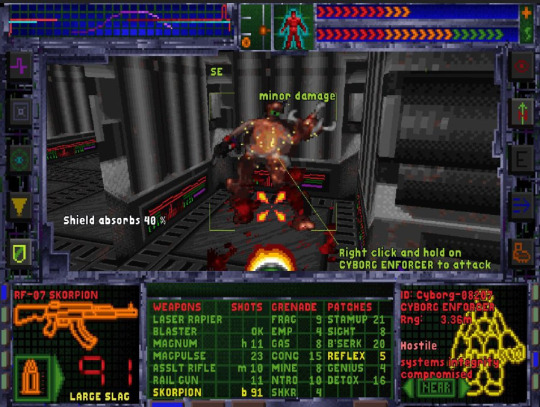
System Shock: Enhanced Edition - GOG / Steam System Shock 2 - GOG / Steam Steam Bundle
Enhanced Edition, much like some of the rereleases for the Build Engine games, is geared to make the game playable on modern systems, in more ways than one. For instance, in the original game, you cannot use the mouse to look around. Enhanced Edition lets you do so. It also comes with the original version of System Shock running in DOSBox, if you’re so inclined to play it.
System Shock 2 has a whole slew of mods and patches, too many for me to discern and sort through. Maybe I’ll update this once I actually play the game so I can put up only the worthwhile fixes and mods.
Look at you, hacker. A pathetic creature of meat and bone. Panting and sweating as you run through my corridors. How can you challenge a perfect immortal machine?
THIEF (1998/2000)
A bit of a departure from most of the games on this list, even other Looking Glass games, Thief is primarily a stealth game, focusing on moving quietly and discreetly while swiping rare artifacts and precious heirlooms. Though Garrett, the player character, often finds himself in much darker conspiracies throughout his adventures.
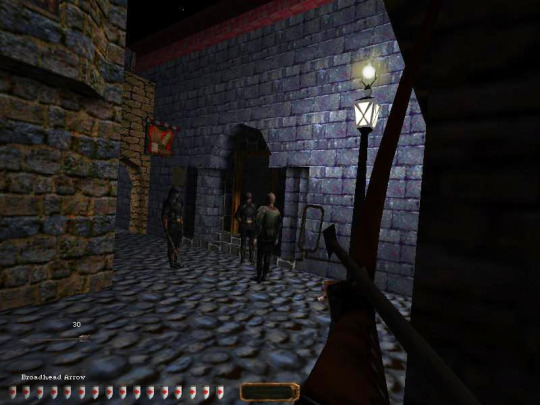
Thief: Gold - GOG / Steam Thief II: The Metal Age - GOG / Steam Steam Bundle (includes Thief 3 and the crappy Thief reboot)
Thief Gold has a patch called TFix that helps the game run on modern systems. Thief II has a similar patch called Tafferpatcher. Both games use the same engine, which was also used for System Shock 2.
Some people in The City are too rich for their own good. Lucky they have me to give them a hand.
ION STORM
Ion Storm is kind of weird to look back on in hindsight. John Romero was essentially forced out of id Software after Quake came out because he spent too much time goofing around and not actually working, so he got back with his buddy Tom Hall, and they formed Ion Storm. They managed to bring in Warren Spector and some other talent from Looking Glass as well.
DAIKATANA (2000)
Okay, I’ll be honest, this is not that good of a game, but it has historical significance so I’m including it. Mr. Romero was feeling a bit big in his britches and wanted to make the best game ever. This game would be Daikatana, featuring quite possibly the most infamous and aggressive marketing campaign in gaming history. You play as Hiro, and along with your allies Superfly and Mikiko, you must fix the timeline and prevent the evil Mishima from rewriting history and becoming ruler of the world.

Daikatana - GOG / Steam
Daikatana runs on the Quake 2 engine, which is fairly flexible and should run out of the box. Romero put out the source code for the game a year after release, and from that we got the 1.3 patch, which is still being maintained by the few fans this game has.
John Romero’s about to make you his bitch.
DEUS EX (2000)
While the Dallas studio was plagued with problems of ego, Ion Storm Austin diligently worked with Warren Spector to create the cyberpunk Deus Ex. The themes and topics in this game are honestly more relevant today than they were when the game released. You play as JC Denton, a cybernetically enhanced anti-terrorist agent who gets caught up in a web of conspiracies involving organizations like the Illuminati.
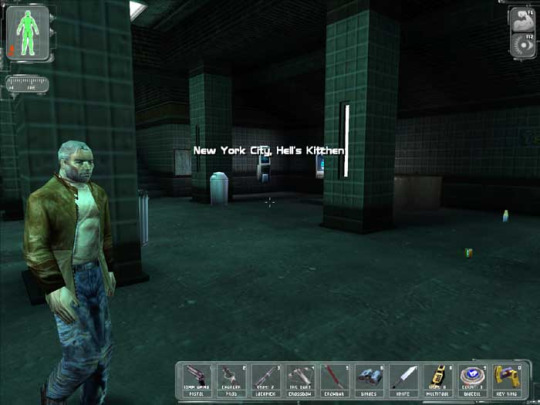
Deus Ex: Game of the Year Edition - GOG / Steam
Deus Ex runs on the Unreal engine, so it should just work. The Steam version has a bug where music is accidentally omitted from a level, but this is fixed in the GOG version. There are some fanpatches as well, though I dunno which ones are good or necessary.
There’s a Deus Ex 2 but it’s poopy.
My vision is augmented.
OTHER NOTABLE GAMES
There’s still a lot more old-school goodness to play, even though they may not be as big as the ones listed above. They may also deviate a little from definition of “old-school FPS”.
STRIFE (1996)
Even the Doom engine got an immersive sim game. Strife is a fantasy-based adventure FPS where you work with rebels to overthrow The Order. Not to be confused with Strife, the MOBA.

The Original Strife: Veteran Edition - GOG / Steam
This game was in abandonware status for the longest time before Night Dive Studios managed to find the licenses and release this modern version. It uses a fork of GZDoom and comes with a whole host of snazzy features like bloom and anti-aliasing. It even comes with the original files if you just want to play using Chocolate Doom or whatever.
DARK FORCES (1995/1997/1998)
LucasArts were famous for their adventure games, but they wanted a piece of that FPS pie too. Star Wars was and still is the hottest series in sci-fi, so it’s no surprise it had its share of games. The Dark Forces games haven’t aged quite as well as most other games on the list, but if you’re looking for that Star Wars flavor, this is it. You play as Kyle Katarn, an Imperial-turned-mercenary working for whoever forks over the most cash. The cowards at Disney retconned these games with Rogue One.

STAR WARS Dark Forces - GOG / Steam STAR WARS Jedi Knight: Dark Forces II - GOG / Steam Steam Bundle (includes the Jedi Knight games below)
The Steam versions of these games are outdated and many aspects of them just don’t work, like the music. The GOG versions are leagues more functional. Jedi Knight comes with Mysteries of the Sith, which runs on the same engine.
There are no fixes or patches for Dark Forces. XL Engine is the only source port that exists but development on it has been seemingly abandoned, and it remains buggy and unfinished. I can’t even find a proper link to a download, everything keeps 404ing.
Dark Forces II has an unofficial patch and a laundry list of various fixes on its PC Gaming Wiki page. Mysteries of the Sith is much of the same.
JEDI KNIGHT (2002/2003)
Made by Raven Software, who previously made Heretic/Hexen, Jedi Knight continues the adventures of Kyle Katarn, as he obtains the powers of the Force and wields a lightsaber. Shooting sections are in first person, but lightsaber combat is in third person.

STAR WARS Jedi Knight II: Jedi Outcast - GOG / Steam STAR WARS Jedi Knight III: Jedi Academy - GOG / Steam Steam Bundle (includes the Dark Forces games above)
Both games run on the Quake 3 engine, so they should just work fresh from install, though you might need to mess with config files to get proper widescreen resolutions. Jedi Academy still has an active playerbase for its multiplayer!
DESCENT (1995/1996/1999)
Are you sick of being limited to running around on the ground? Then Descent might be for you! Piloting a space ship, you’re given “six degrees of freedom” to bob and weave your way around enemies! You play as a merc hired by a mining corporation to investigate and destroy a computer virus that’s hijacking their mining robots.

Descent - GOG / Steam Descent II - GOG / Steam Descent 3 - GOG / Steam
There are a couple of source ports for Descent. DXX-Rebirth seems focused on maintaining the vanilla feel of the original, and D2X-XL is more focused on adding modern features, like OpenGL rendering. Both of these should work for Descent and Descent II.
Descent 3 does not have any source ports and might require some work to get running.
REDNECK RAMPAGE (1997/1998)
While Duke, Wang, and Caleb stole the show with the Build Engine, Redneck Rampage is still a favorite among some fans. Includes a booze-o-meter!

Redneck Rampage Collection - GOG / Steam
The collection includes all three games in one package. Redneck Rampage is also on Steam but the quality of that version is so poor that you’d be better off just buying the GOG version. One source port exists but is extremely buggy, so you’re better off just playing it with DOSBox.
TUROK (1997/1999)
Most commonly thought of as Nintendo 64 games, Turok did make its way to PC. Turok is a little more arcade-y than most other games of its time, using a checkpoint save system and lives instead of just restarting the level over again like other games. Commit dinozoid genocide as Turok, Son of Stone!

Turok: Dinosaur Hunter - GOG / Steam Turok 2: Seeds of Evil - GOG / Steam
These versions of Turok are remasters done by Night Dive Studios, so they should just work with no issues. N64 soundtrack best soundtrack. They’re drum-tastic!
SERIOUS SAM (2001/2002)
Out of Croatia comes Serious Sam. Including Serious Sam as an “old-school” FPS is pushing it, considering the series was actually made as a throwback to old-school FPS. At this point, it’s done its best to keep old-school traditions alive, so it deserves inclusion. You play as “Serious” Sam Stone, traveling through time to thwart the evil alien Mental.
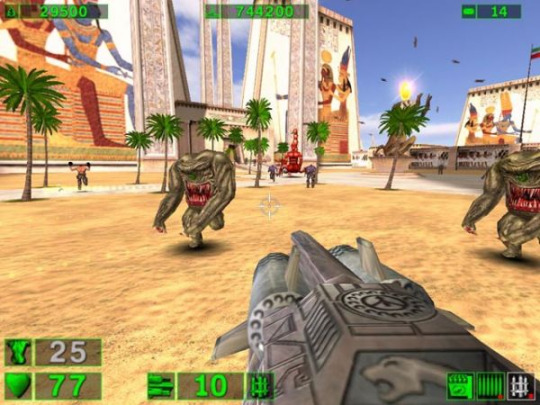
Serious Sam: The First Encounter - GOG / Steam Serious Sam: The Second Encounter - GOG / Steam
Serious Sam HD: The First Encounter - Steam Serious Sam HD: The Second Encounter - Steam
Croteam remade TFE and TSE in a newer version of their Serious Engine, and while the HD versions are the ones I’d personally recommend, the original versions still work great and some people still swear by them over the HD versions. It’s up to you and your preferences.
LET’S WRAP THIS UP
Obviously this list is not the end-all-be-all of EVERY first-person shooter that’s considered “old-school”. There’s pre-Wolf3D stuff like Hovertank 3D and Catacomb 3D. There’s stuff during the mid-late 90s like Blake Stone, Soldier of Fortune, SiN, and Tribes. Hell, there’s even stuff like Rainbow Six and Medal of Honor: Allied Assault, which paved the way for Call of Duty and the rise of modern military FPS. I never promised a full comprehensive list, just stuff I think is notable and fun. Though if you think there’s something vital that’s missing, let me know and I might add it!
If you need help getting some of this stuff to run, I will help if you shoot me a message, but please actually Google your problems before coming to me. Other people have this stuff figured out pretty well, and I will pretty much Google your problem if it’s something I don’t know.
Regardless, please check out these games and have fun! Each one has its own quirks. And remember:

465 notes
·
View notes
Text
Doom WADs’ Roulette (2002): Nimrod
And so, we reached the last partial/total conversion on the Doomworld’s top 10 WADs from 2002.
And honestly, I wish it was a better send-off to these.
#5: Ni'mRoD - IXNAY on the HOMBRE
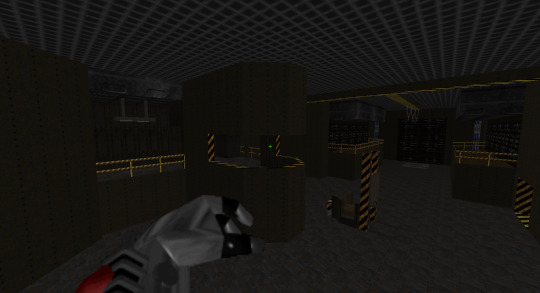
Main author(s): Unholy Software
Release date: July 23rd, 2002 (original release)/September 11th, 2005(GZDoom update version, database)
Version(s) played: GZDoom update
Required port compatibility: Doom Legacy/GZDoom
Levels: 10
Okay, I know I sound kind of pessimistic, but my first impressions with Nimrod were, let’s say, not really good. Despite seeing many people praising this WAD, I’ve found many problems that my first playthrough made me feel like I don’t want to touch it ever again. But I’ll elaborate on that later.
So let’s see who made this WAD, shall we (don’t send any threats to these folks, people!)?
We have Kristian Käll, who created 2001’s Phobia (later turned into Despair) and was leading the project behind Nimrod.
We have Paul Corfiatis, who was the main contributor behind 2002 A Doom Odyssey (most of the levels and the soundtrack) and was one of the composers for this WAD.
We have Sam Woodman, the author of the (in)famous Alien Vendetta map, Demonic Hordes, who also made two tracks for this WAD.
And finally, we have James Haley, the man behind Eternity Engine, who helped with the FraggleScript for Nimrod.
There are still other people who contributed to the creation of this WAD. Check the nimrod_team text file, or the Doom Wiki page to get the full list.
As for the story, you play as the titular Nimrod, a UAC soldier that was turned into a cyborg, 30 years after the events of Doom II. You are playing poker with some buddies in an abandoned storage facility when all of the sudden, shit turns into the typical Doom WAD plot AKA you being the last survivor cleaning up UAC’s mess.
And as you progress through the WAD, you find out that this mess is happening due to the original teleporters. Not because they are working but because they might cause more shitshow for humanity. Now stored in a place/planet called ExDeus, you have to go there to blow up these junks to make sure nothing bad will happen with these being used.
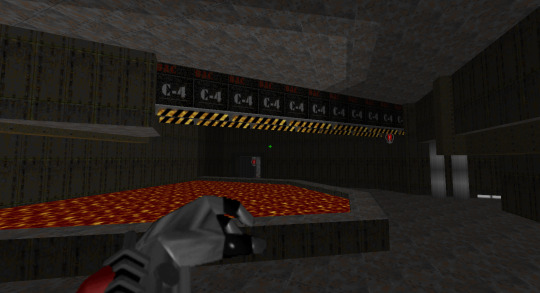
What I like about this plot is that it’s not invasive. It doesn’t force you to stop to read some stuff about it as much as some of the other WADs that used this technic in the past. There is even a cutscene in the second map where you talk to another person and he gives you a gun.
What I didn’t notice during my first playthrough, is that in the second half, your commander can’t communicate with you, so he leaves messages inside of the GZDoom’s console command (and I wish that it was written how to use this mechanic in the textfile rather than thinking that I must press other keys to read the messages).
Let’s continue out with an even more positive note. This WAD looks very good. While it focuses almost entirely on the style of the oppressive, industrial-like factories/tech bases, sometimes its architecture looks incredible. Which says something since, as I said earlier, you start off in an abandoned storage facility.
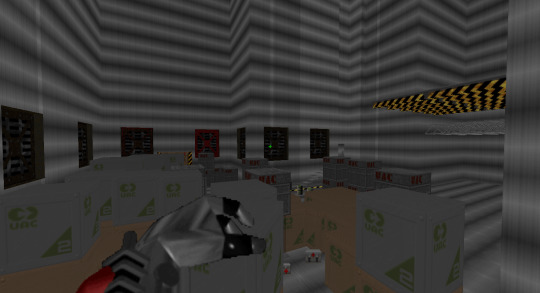
Almost all of your weapons and most of the enemies got changed sprites. It’s mostly digitalized 3D models and they look fine. I don’t think I have any problems with them. The rest of the sprite work is also good.
What I don’t like, however, is that the maps are sometimes too dark. You will be walking around it until you end up in the room/area where you can barely see anything. God help the poor bastards who play this WAD and suddenly a little bit of natural light comes at their monitors and makes them blind as a bat.

Changing the subject into something more positive: the music. It’s also good. If some of you may notice that it seems to repeat itself, that’s because it has a leitmotif. And as for my favorite track, it’s called Angry Riots, Troopers Yell from MAP07 (despite the fact that I muted the music on my first playthrough ‘cause this map gave me a White Fever).
The sound effects were fine, I guess? I’ve heard some of these from Doom 64 (like the Dark 7 Duology) and these are always at least good. The rest of the sound effects were... well I wouldn’t call them bad but I feel like it all needed some additional work on them. The worst was the one where it resembled something smashing against the floor or ceiling and it sounds horribly bit-crushed, sounds too loud in some places, and is just downright terrible. Didn’t help that I had to listen to this one many times during my journey through Nimrod.
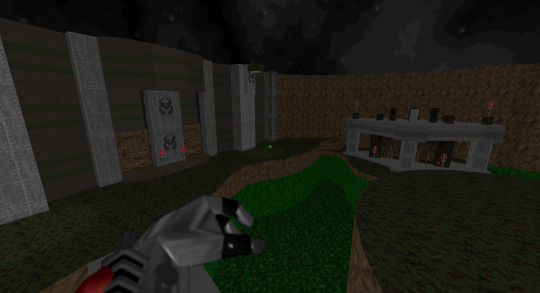
Believe it or not, there is an actual voice acting in this WAD (plus some additional stuff from the voice synthesizer). Mostly prominent in the first four levels. And the quality is mixed in my opinion. Nimrod and Havoc sound pretty fine, but the commander sounds like garbage. Couldn’t they just make his voice just a little bit bit-crushed instead of making him sound like a diet, HECU Marine?
Also, the status bar looks somewhat unreadable. I keep getting numbers wrong.

That’s all about the visual stuff from me. But what about the gameplay though? How does it feel to play Nimrod without focusing on combat and monsters?
Well, it’s more complex than the typical Doom stuff. It’s not just going from one place to another while looking for keys. You are given a task to do on most of the maps like blowing up all of the old teleporters in The Alpha Outpost, charging one of the batteries in The Twice Risen Starport, or overloading one of the machines in The Underground Sewer Facility.
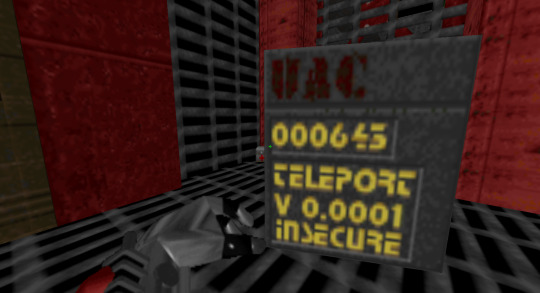
This WAD is split into three locations. You start out on Phobos (where you spend most of the time here), then crash onto ExDeus, and finally end up near the nuclear missiles facility on Mars.
Sometimes you have to pick up an item to place it somewhere to go further, like the previously mentioned batteries and explosives. One of these items will actually lead you to the secret area if you know where to look (it’s in Crate Factory).
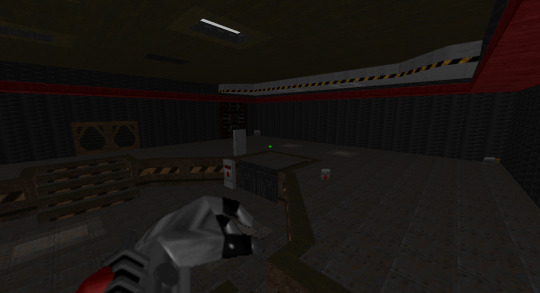
Also, you have to remember this thing: Jumping is important! It is required to go further to get an item or a key or get into a switch or something else.
There is one funny thing related to the old teleporters mentioned earlier, where you have to destroy the last one by using a crane to drop from a high altitude. It’s really funny.
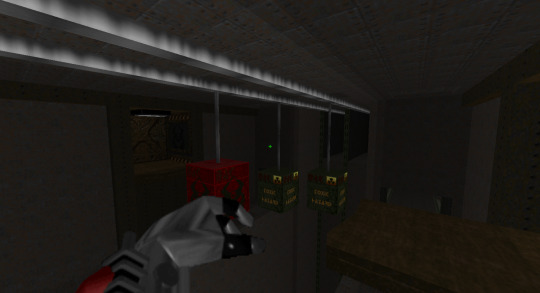
But you know what’s not funny? How really complicated most of the maps are. To the point that during your first playthrough you might be thinking that you are playing the spiritual successor to Eternal Doom and/or Herian 2. And that you start cheating because you are sick of these.
Let’s start with the level geometry. Many of these levels feel like some kind of double-jointed Frankenstein’s monster of a map. Even if you know where you are supposed to go and what to do next, you will still get lost due to how levels’ gigantic amount of passages lead to the same room/rooms.
Stuff connected with items is more tolerable but not as much. I already mentioned the dark rooms where you can barely see anything, and I’m mentioning it again because it is also related to the items other than keys/parts of the human body. It doesn’t help that some of these items tend to blend with the environment of the room that is placed. You might even think they are part of a map itself, thinking that they are just an added detail because it looks funny but nope. They are pickable and required.
And let me tell you something. The Alpha Outpost might have my favorite music track in this WAD but it might also be the most overly complicated level in Nimrod. I’ve already mentioned most of the stuff earlier that adds to my dislike for this level but let me tell you about the yellow key. It’s in a watch tower, behind the yellow door. How do you get it then without thinking: Why did the author put the key there in the first place? You break the window near the door to get there... Yeah, something that might never come to your head when first time playing if you played already many WADs that don’t require something like that unless you watch/read a walkthrough on the internet.
...
You know, I should have gone apeshit at this point, but by now I think I’m starting to have a burnout from playing Doom WADs. I had to play one level per hour (or something close to that timeframe) while screenshotting keys’/secrets’ locations to not go insane.
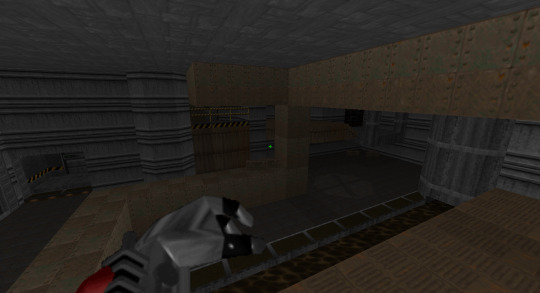
Let’s change the subject. How hard is Nimrod? Well, it’s somewhere in between. Rather average. If you know where the items are along with the secrets, I don’t really think you will have problems with this WAD.
But it still has some bullshit sprinkled around, like fighting three Arachnotrons on the first map, the big groups of Hoovies in later levels (and placed in a dickish way), and new high-tier monsters that are in dozens in some of the maps.
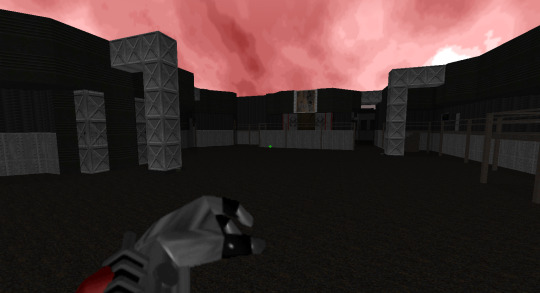
And speaking of the new enemies, there are a few of these:
Instead of Zombiemen, you are now fighting Undead Guards, who will fire at you either like Zombiemen or SS-men. Other hitscanners are here but only Hoovies look different (along with Imps).
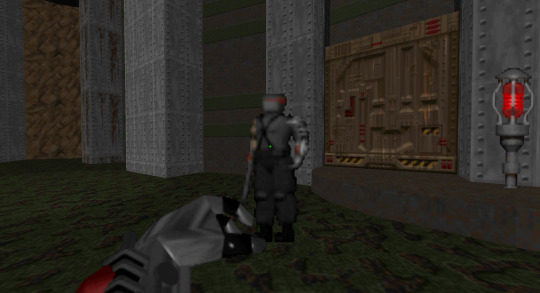
Pinkies are now bigger and black and they, like, propel fastly towards their target with their mouths. Also, they are using the name that will be used in the future by the infamous Sequel Trilogy hater: Longman of YouTube.
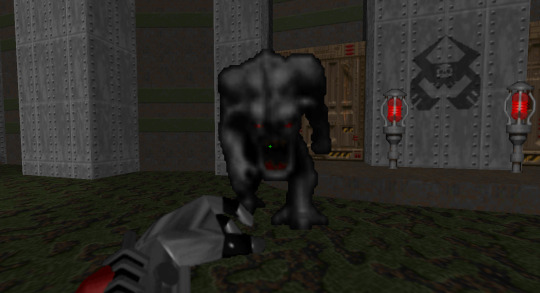
We have Badasses, green-colored cyborgs who shoot plasma at you, at a faster rate than spiders, and are worse than the hitscanners (same pain state chance as Barons I believe). I like to call them The Bruh Men since when they are awakened they say something that sounds like Bruh.
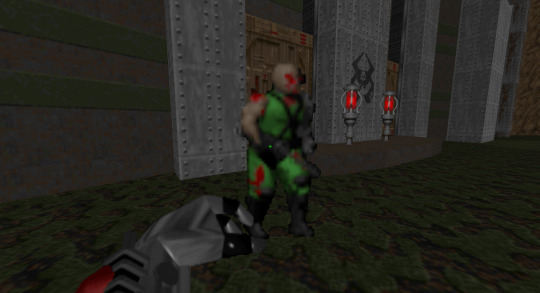
There is the red variant of these in The Underground Sewer Facility that you have to kill to rip his eye out to finish the level.
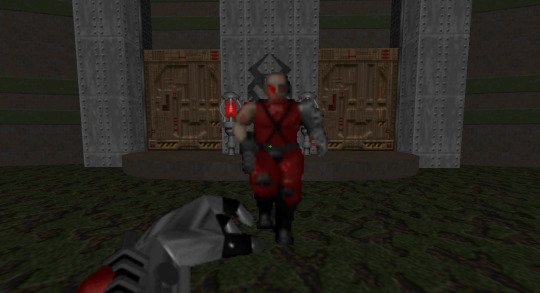
You won’t find any barons in this WAD. Instead, there are Archdemons, AKA Let’s make Arch-vile but without any indication that he’s attacking you and with a smaller timeframe to hide from his attack. They are bullshit.

Also, we have BAM, a huge cyborg that either shoots two Hellraiser’s blasts or hitscans your ass. He’s also bullshit.
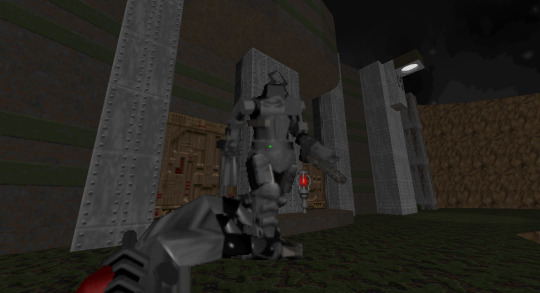
So yeah, half of the new roster is basically Let’s make a new monster out of the old monster but more unfair to fight.
Do you at least have a good arsenal to fight them? Well, it’s hard to actually tell. Shotgun and Chaingun (now titled Panzer Bullet Chaingun) fire at a faster rate but that’s basically it for all of the weapons. The only exception is the previously mentioned Hellraiser, which kind of works like some kind of mini-nuke that obliterates every monster (including you) that is not Spider Mastermind or BAM. And in their case you need much more blasts than BFG to put them down, making this weapon obsolete on them (at least in terms of the Huge B8tch).
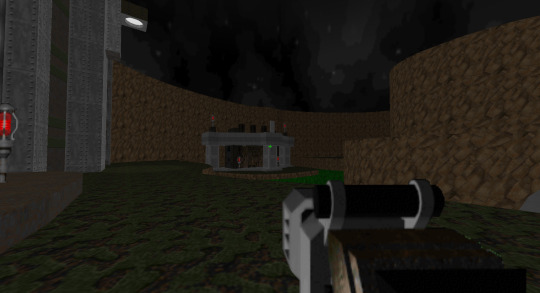
Even though the GZDoom version is playable and I didn’t encounter any bugs for almost all of the WAD, it can't be beaten without noclipping due to the one blue door in Shipping/Receiving/Spaceport.
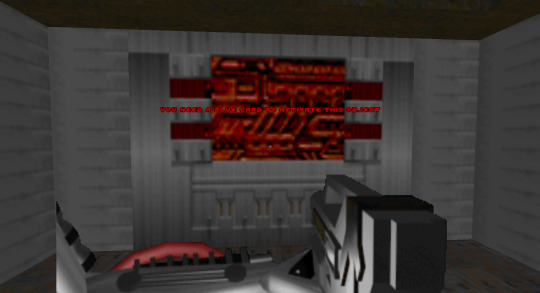
For some reason, it requires a specific type of key to be open (keycard) but there is a problem: THERE IS NO SUCH A THING AS BLUE KEYCARD IN THIS WAD! Every human body part that you will find is slotted as Blue Skull. I even tried to summon the keycard myself and all I got was just some bullets. So basically, if you want to complete this level without cheating, then you are screwed. Other doors in this map don’t act like that (except the one that requires all three colors) so this piece of junk feels like an omitted game-breaking bug.
...
sigh
That was Nimrod, people. I had no expectations for this WAD, and I still ended up with mixed feelings about it. I can definitely see that it has a heart due to all of these 3D models created and this WAD’s plot trying to give you a reason why are you doing these things. The problem, however, is that it’s mostly unnecessarily complicated, sometimes cheap in difficulty, and downright unbeatable due to the one door in MAP06 if you want to play the entire WAD in one go.
Then again, that’s probably what happens when you try to create a Singleplayer WAD experience when started as a Deathmatch package idea.

And I’m glad I’m done with this WAD since I’ve played three WADs in a row (not counting the first Dark 7) that were either partial or total conversion.
Good news though, the next WAD on the list is not like the ones from the near past. The bad news is that it’s a Doom I WAD made by a guy who probably made the least enjoyable maps in 2002 A Doom Odyssey.
...
You know what they say: You win some. You lose some.
See you guys next time.
#doom#Doom WAD#review#doom mod#Doom 2#2002#doom 2002#Ni'mRoD - IXNAY on the HOMBRE#nimrod#doom nimrod#Doom WADs’ Roulette
1 note
·
View note
Text
20 Years.
Two-thirds of a lifetime ago, a ten-year-old boy in a scratchy wool sweater sat huddled under an old down blanket. The first proper snow of the season had come the week before, and the boy hadn’t been dressed for building forts. Now here he was - bored, sick and sweaty. His mother entered the room with a mug of undrinkably hot milk with honey and butter. In her other hand was an issue of GAME.EXE, a computer gaming magazine. The words “HALF-LIFE” were plastered across the bottom of the cover. The boy loved reading, and loved computers, and the milk needed time to cool off anyway. He opened the magazine and flipped to page 8 after finding it in the table of contents. The boy grew older and switched languages, countries and continents, but his favorite game never changed.
-
It’s hard to compress two decades into text, but I will attempt to do so when it comes to my relationship with the Half-Life series that began all those years ago, with that preview article in that magazine.
The article was written in a second-person perspective that really stuck out to me, and was filled with screenshots that would later turn out to be of an unreleased rough beta version of the game. It ran through several dramatized, episodic descriptions of events in the game, then listed out the weapons used in the game, the enemies you would face and the tactics to deal with them. Finally, there was an interview with Marc Laidlaw himself. This single article was sufficient to make me completely insufferable to my parents for the next few months. “I want to play Half-Life,” I would say. At first, this meant asking to go to an Internet cafe a few blocks away from home, and for money to pay by the hour and use one of their beefy gaming PCs. Later on, it meant asking for a copy of the game, and for time on the “main” home computer - the only machine that could run the game at all, in glorious 320x240 resolution that gave me headaches.
-
A couple of years passed. The move to the US threw everything into a pleasant state of disarray, but the one thing that hadn’t changed was having to ask my parents to use the computer to play Half-Life. I had found one of my own soon after arriving in the States, but it had no sound card. It was there, on my mother’s computer, that I finally beat the game. My thirteenth birthday present was a copy of the newly released Opposing Force expansion. My birthday cake featured an edible photo of myself playing in a fountain in downtown Chicago, which my mother doodled over with brightly colored frosting. I was now knee-deep in toxic green sludge, a crowbar in one hand, and a proud Lambda logo on my chest.
Most kids in my 8th and 9th grade classes didn’t share my enthusiasm for Half-Life. They played console games and were rightfully hyped about the Playstation 2 and X-Box. In search of like-minded people, I took to the Internet. My options for getting online in 2001 were limited to libraries - either during lunch at school, or at the Naperville Public Library, which was a hour-long walk from home. I discovered Planet Half-Life, an offshoot of the Gamespy network. Through it, I discovered the fact that my favorite game was designed from the ground up to be moddable. I learned of Counter-Strike, Team Fortress Classic, and Sven Co-op. I discovered the Handy Vandal’s Almanac and The Snarkpit, two communities focused on level design. Having no reliable internet at home, I downloaded the level editor - then called Worldcraft - onto a floppy drive and brought it home to install. For the first time, I wasn’t simply playing the game. My parents looked on as I worked to figure out the obtuse user interface, trying to remember what I’d read earlier in the day. They raised their eyebrows when I finally managed to compile and run my first level - a hollow, unlit concrete box 512 units across with a single prefab trashcan hovering in the center. There wasn’t much more I could do in the limited time I was allowed to use the good computer, but I had caught the bug. My notebooks were filled with doodles of level layouts, my mind filled with cheesy storylines to match.
Eventually my family moved to a house with proper internet access, and I got a set of hardware with enough power under the hood to run both the game and the editor. It could even produce sound! All the things I could only read and salivate about were now within my reach, and I gorged myself on them. Counter-Strike quickly fell by the wayside, but Team Fortress and Sven Co-Op did not. Natural Selection came out and blew me away with how different a Half-Life mod could look and feel from the original game. I stayed up past midnight, playing, building, and playing some more. I learned that projects can die - when the extremely tongue-in-cheek Scientist Slaughterhouse mod went silent.
The release of the Half-Life 2 trailer took everybody by surprise. I had called one of my like-minded friends and we synch-watched it together, pausing every few minutes to let the video buffer and gush about how amazing everything looked and how much we were looking forward to messing with the modding toolkit. The subsequent beta leak and resulting delays taught me to be patient.
The move to California was not long after, and my patience was immediately put to the test as most of my belongings were stuck with the moving company, including my computer. I must have gone through a full pack of printer paper in less than a month, drawing up concepts and layouts for Xen Rebels, a mod centered around a semi-peaceful human colonization of the realm set after the events of Half-Life. Once my computer arrived, it was right back to the late nights and groggy mornings for me. Our home Internet was bad but workable, and I spent countless hours with the new and more creative mods that were being released, including The Specialists - a strong attempt to recreate the gun-fighting and martial arts stylings of Hong-Kong action movies in a multiplayer game. Around the same time I was introduced to the strange new world of anime, and decided that I simply must change the two throwable knives offered by The Specialists into kunai and throwing needles. This of course required me to learn 3D modelling. At the time, this was done with Milkshape 3D, a model editor compatible with most contemporary game formats. Once again, countless hours of figuring out the interface and the workflow followed, set to the calming tones of the Unreal, Deus Ex and Half-Life soundtracks. Creating models felt a lot more freeform than levels as I wasn’t constrained to a unit grid or forced to use convex geometry, and one day the new throwing weapons were in. I published the modified models on a forum to exactly zero fanfare. Around the same time, I began learning the basics of Photoshop in school, so modelling and texturing went hand in hand. To say my early textures were atrocious would be an affront to honest, hard-working atrocious textures the world over, but I continued my studies. My experience with working in 3D even netted me a 2nd place award at the school art contest - money which I immediately put back into upgrading my computer.
Half-Life 2 came out in November of 2004, to universal praise and celebration. I received the collector’s edition as a present for New Year, along with a copy of Raising The Bar. I beat the game the same morning, without a wink of sleep between unwrapping my present and the final darkness of the credits screen. The SDK didn’t ship with the game, but as soon as it was released I dove in. Soon after, the modding community blossomed, bigger and more vibrant than the original game’s, driven by the incredible flexibility of the engine. One of the first mods that appeared was made by a British man named Garry, and was called simply that, “Garry’s Mod”. It let players interact with the physics engine, and slowly sprouted more and more features. Many players used these features to pose character ragdolls, eventually creating entire comic series with storylines ranging from the comedic non-sequitur to dark and serious. Of course I felt the need to try my hand at it. That lead to the creation of The Plane - the story of Beet, a Combine Elite who managed to break free of his overseers’ indoctrination and find friendship, love, and revenge on his old masters. The only redeeming feature of that story was that it taught me how not to write stories.
I began getting more attached to the Gmod community than the expressly level design one at The Snarkpit. The few levels I publicly released were designed specifically as sandboxes to play and build in. The most popular ones were gm_orbit and rp_bahamut, maps set in space and featuring zero gravity for physical objects, allowing players to build smaller spaceships, or roleplay as the crew of a salvage and exploration vessel. Posting teaser images on the forums taught me a valuable lesson - what it felt like to be the one creating hype, instead of experiencing it. The constant demands were overwhelming. Some would simply want more work-in-progress screenshots. Others would drop ultimatums that unless a certain feature was designed a certain way, they would refuse to use the map. Others yet attempted to worm their way into getting the map early, offering to test it and provide feedback. I had almost deleted each project multiple times before finally releasing it.
Life happened, and things with Half-Life slowed down. When the Orange Box came out in 2006, I attempted to get it at a five-finger discount at a local Target. I got caught. Indirectly thought it was, Half-Life taught me that idiocy often leads to consequences. Buying it legitimately later in the year and playing through Episode Two reminded me that some stories aren’t written to end neatly.
It was in 2007 that I bought a membership for the Something Awful forums, and discovered an avid and very exclusive community of Gmod players. Over the course of the following decade, most of these people remained in constant contact with me, and will probably remain so for the foreseeable future. I became an admin once we opened our serves to the public - moderating the newcomers and mentoring the unskilled. One of the people had a project in mind, and I began creating models again. Miraculously, Milkshape 3D remained compatible with the Source engine, so I worked with it until I learned Maya. This project would eventually become known as Armored Combat Framework, and be released to the Gmod community at large. I learned how to iterate designs based on feedback, and how it felt to work in a well organized team.
Frontier happened around 2010, and was another lesson in teamwork - specifically what happens when things break down without role redundancy. Ambitions ran high, and the hype mounted. The programmer eventually left, and all that remains of the project is the very videos and images that were used to hype it in the first place, and a folder full of now-useless models, maps and textures. That was probably what prompted me to start pulling away from Half-Life and Gmod in general.
Black Mesa came out in 2012 and breathed a new life into my old obsession. I played through the original Half-Life again, then through the remake, noting the differences and the tweaks to make the gameplay more palatable to modern-day players. It felt good, like putting on an old but comfortable jacket. I’d fire up the SDK now and then, mostly to help newer, more driven designers. Two of the guys from Team Frontier went on to work in the industry full-time. There were whispers of a new game in the works, minor leaks of file and folder names hidden away in Valve projects. Episode 3 turned into Half-Life 3. A full sequel, rather than another short episode, as originally planned. “HL3 Confirmed” became a meme, but the people at the top remained silent.
Life kept happening, as it does. I lost people, I found people. I left home. Every now and then I’d fire up HL or BM again, or drop by the old Gmod server. I’d build things and model things, and release none of it to the public. I watched as the Dota International became the most widely spectated event in gaming, making players, sponsors, and Valve millions. The realization slowly started settling in. Then Marc Laidlaw retired, and later posted the Epistle. The workers at Valve spoke of a lack of direction and stagnation that comes with a cornered market. Modding for an engine over a decade old, no matter how advanced, slowed down.
It’s a different world now. Unity and Unreal engines rule the scene. Survival and Battle Royale have become the new buzzwords. Microtransactions. Loot boxes. Streaming integration. Freemium. E-Sports. Mobile gaming. Virtual Reality. If a new Half-Life were to appear today, would it be changed by the zeitgeist, or would it stay the course set by its predecessors? I don’t know. But there’s one thing that the escapades of a mute, bespectacled research associate have taught me more than anything else: hope.
2 notes
·
View notes
Text
Soft Spot - Flat Instance (29/09/20)

On the 26th of September, I had the pleasure of stepping foot back in a physical gallery as lockdown restrictions began to ease and I was back in Manchester. Flat Instance at Soft Spot brings together the work of Ben Allan, Owen Herbet, and Babs Smith. Beautifully curated, the three artists each attempt to make tangible, something otherwise fleeting.


(Source)
Owen Herbert’s 13:43 documents the rainfall on the 19th of August in setting plaster, before using crater mapping software to translate this data into sound. This echoing soundtrack of a moment in time perfectly preserved, becomes a melancholic background that fills the gallery- accompanying the other artworks. The cratered plaster becomes the centerpiece of the first gallery. Before your eye is drawn onto Ben Allan’s surrounding work.

Ben Allan’s ‘Undoing’ prints draw you in with questions, reminiscent of ink blot tests, these 3D models of sculptures, peeled and lay flat, subvert the surface and materiality, leaving only questions about the pervasiveness of their cultural significance and what remains in these dismantled forms. These sentiments are mirrored in his second work, ‘Impervious to all Weather Conditions’, 10 stones are removed from the natural processes through which they are created, perfectly preserved. By altering the states of both objects, changing how they can be interacted with, the ‘afterlife’ of these objects is drawn into question.

Finally, Babs Smith, from the University of Salford 2020 graduating class, fills the second gallery space with her collection of works ‘Signs of Life’. Light shone through warped and etched captures the imagination in the way it reflects across the walls. Captured in video at the top of the stairs, this cryptic foreshadowing of the work is made clear in the physical. The perspex pieces, in conjunction with warped discards from a demolition site, begin to give form to the energy left in place when something is destroyed. The bleached photographs hint to the memories that once belonged there, and the piece tries to reconcile what is left after the dust has settled.

The show was thoughtful, It seemed, in it’s minimalism, to be greeting us back in the same tender yet tentative way we have become accustomed to, setting into the new normal. A sense of grief of what we have lost and missed, but a silent joy of being back with loved ones, in familiar places.
On a personal note, this show got me excited about the prospect of making ambitious artwork again. Babs Smith, as someone I know from Salford has set a president for what can be achieved so soon after graduation.
Thinking about curation also, this show got me excited about the possibility of curating some kind of show- be it digital or finding a venue when restrictions ease up a little. The strong theme of the show and the spotlight it shone on emerging artists I found really thought provoking and encouraged me to pursue my own ideas. This show was a welcome reminder of what ambition can achieve.
0 notes
Text
From Wireframes to 3D Demons: The History of the First-Person Shooter

What game do you think was the first first-person shooter (FPS)? You probably have a title in mind, but there’s a good chance you’re thinking too contemporary. It’s common for games like Doom and Wolfenstein 3D to take the spotlight as pioneers of the genre, but id Software’s 3D romps came years after ambitious minds introduced players to the true first FPS.
To follow the history of any video game genre, you almost always have to go back to the beginning. Long before expansive worlds and high-def visuals became the norm, studios were merely struggling to make gaming work. Computers weren’t built to play on. They were intended to crunch numbers and process words. However, savvy minds constantly sought innovation - and during the 1970s, gaming was starting to stir curiosities. Enter three high school students - Steve Colley, Howard Palmer, and Greg Thompson - tinkering on an Imlac PDS-1 at the NASA Ames Research Center.
First-Person Shooters in Their Infancy
By 1973, gaming was already a known medium, with titles like The Oregon Trail, Pong, and Galaxy Game showcasing the wonders of technology. Colley took things a step further by creating a 3D environment built out of a 16x32 wireframe and providing the framework for Maze War. It was a simple concept that even Colley admits “quickly became boring.” The future nCUBE founder has a fuzzy memory over what happened next, but he knows either Palmer or Thompson came up with the idea of inserting people into the maze. A shooting mechanic came soon after, followed by the ability to play against a human opponent using a serial cable. They didn’t know it at the time, but Colley, Palmer, and Thompson had just released the earliest incarnations of the first-person shooter.
youtube
While the three students were working on Maze War, halfway across the country at the University of Illinois at Urbana-Champaign, student Jim Bowery was busy with his own wireframe space shooter. The basis of his idea used the PLATO computer network and followed the green outline of a spaceship across a 3D environment. Spasim, short for “space simulator,” officially released in March 1974, putting it only months behind Maze War. Since the development timeline for Colley’s Maze War is a little murky, the two games are often both considered the trailblazers of first-person shooters.
The 80s Advance the Genre
Maze War and Spasim gave the genre a footing on computer platforms, but come the turn of the decade, Atari was ready to bring it into a more public setting. In November 1980, Battlezone entered arcades across the United States. Using a gimmicky “periscope” viewfinder, players took control of a tank in a wireframe environment. Other tanks and hazards littered the playing field, which was fully 3D and allowed players to navigate fluidly across a 360-degree horizontal plane.
Battlezone became a hit and, starting in 1983, was ported onto the Atari 2600, Apple II, Commodore 64, IBM PC, and VIC-20. It was the first game of this still juvenile genre to release to a mass market, and it did so with success, making it the first 3D game to garner much attention.

The concept of 3D mazes introduced in Maze War reemerged in 1987 with MIDI Maze. Xanth Software F/X replaced wireframing with solid, untextured walls and allowed players to move freely rather than relegate them to 90-degree turns. The cutesy shooter featured AI-controlled smiley-faced drones and a 16-player multiplayer mode made possible via the Atari ST’s MIDI ports. The game received ample praise and was named by CNET Gamecenter as one of the “10 most innovative computer games of all time.”
Developers may have made great strides in the FPS genre during the 80s, but it was the 1990s that ultimately gave its inception a bloody, controversial face.
Heavy-Metal Popularizes First-Person Shooters
John Romero had an extensive library of games under his belt before he, programmer John Carmack, and the small team that became id Software set their sights on bringing fully immersive 3D experiences to the computer. It’s easy to mistake Wolfenstein 3D and Doom as Romero’s first attempts at revolutionizing first-person shooters, but games like Hovertank 3D served as the framework for these pioneers. Set across multiple maze-like levels, Hovertank pits players against enemies that look like early versions of classic Doom demons. The goal is simple: maneuver a tank through levels to save human sprites from certain death.

It’s a game largely forgotten by time, but it was a stepping stone for Romero that ultimately led to Wolfenstein 3D. The base game looked very familiar to Hovertank, with levels divided into rooms by now-textured walls. Additionally, players could finally see their weapon, which featured unique firing animations for each firearm. Wolfenstein may have predated Doom, but the demonic first-person shooter and its heavy metal soundtrack really drove the popularity behind the first-person shooter. Other games, like Bungie’s Pathways into Darkness (1993), tried to cash in on Wolfenstein’s model, but never garnered the popularity needed. Doom may seem like a simple concept today, but in the early 90s, PC gaming was still very basic. It proved the power and capabilities of 3D gaming by delivering a smooth, fully-immersive world that heightened what Romero and Carmack accomplished with Wolfenstein.
The demon killing-spree that ultimately gave life to the FPS genre became an inspiration for developers. It didn’t take long for copy cats to start popping up, like Gary Design Associates’ Nitemare 3D (1994) and Bungie’s Marathon (1994). Even id Software tried to recapture the that magic with Heretic and Hexen, but kept coming up short. In 1996, Romero and id revamped their 3D engine, brought on Trent Reznor’s musical talents, and delivered Quake. Its real-time rendering and 3D acceleration added another technically impressive layer to 3D gaming. The success of Quake didn’t quite reach that of Doom’s, but one can argue it paved the way for machinima, or creating cinematic experiences using real-time graphics.
First-Person Shooters of Today
After id Software laid the groundwork for 3D first-person shooters, it was only a matter of time before a developer would craft an experience that further advanced the genre. As it turns out, there were quite a few coming down the pipeline. The mid to late-90s - 1998 in particular - were ripe with FPS games, including Tom Clancy’s Rainbow Six, Epic Games’ Unreal, Turok: Dinosaur Hunter, Half-Life, System Shock, and one of the first successful multiplayer titles, GoldenEye 007. The importance of story and immersion was on the rise, and each of these iconic games played their own role in shaping the future of first-person shooters.

Without Half-Life, we wouldn’t have Team Fortress, Counter-Strike, Portal, or Left 4 Dead. Without Rainbow Six, players wouldn’t have the competitive outlet of Siege. System Shock (1999) later gave life to the BioShock series. Medal of Honor, Battlefield, Call of Duty, Halo, Crysis, Far Cry, Outlast, Overwatch, and any other first-person shooter that graces your gaming library wouldn’t exist if not for the efforts of the incredible minds that created and advanced the genre.
First-person shooters have come a long way since their wireframe beginning, and there’s still always room for advancements. Virtual reality and whole-body immersion are on the map as the next to find their way into the average household. But no matter how advanced the genre gets, we’ll always find ourselves downloading our umpteenth copy of Doom and gleefully slaying our way through id Software’s demonic horde.
At SJR Research, we specialize in creating compelling narratives and provide research to give your game the kind of details that engage your players and create a resonant world they want to spend time in. If you are interested in learning more about our gaming research services, you can browse SJR Research’s service on our site at SJR Research.
0 notes
Text
TASK 3: DISCUSSION 2
The Evolution Of Animation
Animation is the method of generating the illusion of motion that are projected in a fast sequence of 24 frames per second. The first animated cartoon to be shown at the Optique Theatre in Paris is the very first historical documented cartoon at Grevin Museum. One of the films were Pauvre Pierrot also known as Poor Pete, which was fifteen minutes in length and the only surviving example with 500 individually, hand-painted frames.
Since then, animation has evolved to a wide range of art styles, techniques, storytelling, technological advancements and employment opportunities of different design and technology. Looking back at how animated films commenced to nurture, we optically distinguished it in the same way that we focus on the history of popular art.
Traditional animation consisted of sketches, drawings, paintings, particularly hand-made visual pieces made with worldly physical material. Cel Animation is a transparent sheet composed of nitrate and camphor cellulose applied in the composition of hand drawn gadgets. Combined with stop-motion, the two-dimensional static art of the illustrator came alive and created pure and creative cinematic images: animals and other inanimate objects could become evil villains or heroes. (Animated Films, n.d.)
The first full-length animated production of Snow White and The Seven Dwarfs in color and sound was in 1937. After which, the first large-scale 2D short animated film was Steamboat Willie in 1928, drawn entirely in black and white with a soundtrack, being Walt Disney's best movie and the first film to release the soundtrack for the movie, pioneering it as a classic film. It was the first of its kind to have been commercially successful and a technologically brilliant, ground-breaking example of Disney animation. Snow White has also received a standing ovation from a star-studded audience. This historical moment in film history has changed the medium of animation. (Disney releases “Snow White and the Seven Dwarfs”, 2009).
As digital technology has improved, it became increasingly popular for use in animation, both for creating and watching animations. In the 1995 Toy Story, which was directed by John Lassetter using computer-generated imagery, which changed the look of the animating industry. Pixar was able to create characters with depth, charm, and personality by use of a complex articulation and motion control system. The film became a massive success with audiences and a new opportunity for an animator to play in various mediums, creating new work prospects and career possibilities for thousands of people. (Arora, n.d.)
The animated television cartoons, classics like Tom and Jerry, Scooby-Doo, were the subject for Hanna-Barbera. All of these are still popular and have been further developed, including live action feature films. Johnny Bravo and The Powerpuff Girls for Cartoon Network are amongst the most recent productions in the studio. Hanna-Barbera was one of the first animated studios to produce television cartoons, and introduced Saturday morning the custom of children's TV. (Saturday Morning Legends: Hanna-Barbera — The Kings of Cartoons — Mark Robinson Writes, 2017)
The distinction between computer animation compared to traditional animation is the creation process.Traditional animation allows you to create several sequential hand-drawn images to construct the illusion of different movements together. 2d animation and traditional animation are very similar, but only the fact that the images are generated using the computer differentiates between them. The images created by the computer are more precise and accurate. Computer animation produces an effect through 2D or 3D models involving the development of traditional 2D animation workspace software, bringing pen and paper to the digital environment to redesign cartoon animation work flows and styles. (Arora, n.d.)
Traditional animation, takes a lot of time and work mainly because it’s handcrafted in 2D , while computer animation is technically created deeming it a lot cheaper and less labour intensive. However, 2D animation is much simpler and works without difficulty, while it may often appear dull and less, it has been in demand following the advent of 3D animation. 3D animation is technically appealing for great quality, although there is limited imagination and lack of simplicity.CGI is now much faster and far cheaper than stopping motion, although it is costly. Viewers who continue to love stop motion videos through CGI because they find that they are personal with the film director in a way that 3D characters can not do.
Animations are not just used simply for entertainment but on a larger scale which includes education, advertising and simulation, etc. Advertisement is an effective weapon to attract people. Lonsdale Saatchi 's dancing Lucozade stick man offers a case in point of advertising animation. This commercial has attracted not just Caribbean people to its website but also neighbouring countries, not forgetting it has generated huge profits.
Simulations are used in cases where people are at risk or unwilling to monitor real-life training. Military education is one of the frequent indicators of this kind of animation use. Example 3D Image Generator for firearms training, the effects can be day-to-day, realistic light, real time, project shadows, animation of the character and mountable vehicles. Simulations are used to produce a predicted outcome of what can happen. (Top 12 Uses of Animation in Various Industries | MAP Systems, n.d.)
Today's animated films, performed in expeditious succession, appears to have smooth modes of action within the compositions. Visually perceiving the old ways of animation and the techniques used now, it reveals how the animation process has progressed and how it is becoming stronger and more preponderant.
0 notes
Text
Dreaming of a New Sinnoh
I’m not quite sure how to start this, because there’s so much to talk about! But before I start with what this is about–the prospect of a Sinnoh Remake–I’ll start with some games we already have.
The last Pokémon remakes we had, almost 3 years ago, was ORAS. And despite whatever opinions you may have on those games, they really did the originals justice. In ORAS, Hoenn was not only remastered, but improved on. The soundtracks were remixed perfectly to fit the purposes they served, and new ones were added in to fit the powerful and emotional plot points and cutscenes that were made possible by the 3DS. With the 3D figures, animations, and surroundings, it was like a whole new experience. Plus, there were new features to enhance these experiences, like soaring and Mega Evolution. When I was Mega Evolving my starter in ORAS, it felt so awesome. I felt more connected with my Pokémon than I have in any other game. This feeling was extrapolated (although not nearly as well) in SuMo, with Z-moves. And with Gen 7, even better effects were introduced, specifically the more realistic character proportions and movements. SuMo also had a map that felt incredibly open, and scenes that were breathtaking.
Now, when ORAS came out, it was like Hoenn, just mirrored in the Kalos style. When I try to imagine Sinnoh remakes, I picture Sinnoh mirrored in Alola style. The 3D movement, proportions, and expressions, on the models of redesigned Sinnoh characters. We got a glimpse of this in SuMo; when battling Cynthia in the Battle Tree, when helping Looker with the UBs, and when encountering trainers that looked awfully similar to Sinnoh NPCs. This was when the speculation for Sinnoh remakes started to really kick into high gear, because people could start to picture it. They could see those beautiful 3D models walking around in the remade environments of Sinnoh. They imagined the cutscene when walking into the Champion’s room and challenging Cynthia. At least, those images started to go through MY head. And once they did, I couldn’t stop! I began to imagine the models of other characters, like the protagonists, and Cyrus, and Barry, and the Gym Leaders. I remembered how the characters in Ruby and Sapphire had been recreated for ORAS, and I started to fantasize: How would GameFreak recreate this Sinnoh character? What expressions would they have? What clothes would they wear? How can they transform the simplistic sprites of a DS game into the complex moving models of a 3DS (or even Switch) game?
That’s when I got excited about the trainers’ Pokémon. The 3D models have been around for 4 years now, and I’m afraid they won’t change. But if you recall, there were VERY few Sinnoh Pokémon in Alola. This was another hint for the speculators. They’re not putting Sinnoh Pokémon in Alola because they’re saving them for the Sinnoh remakes! And that’s a perfectly reasonable assumption to make. What I’m praying for is that the Sinnoh Pokémon can live up to their glory in the remakes. In ORAS, we got new Megas for tons of Hoenn Pokémon, and as I mentioned earlier, it was incredible. As I also mentioned, Z-moves gave me less of a rush. What I fear is that Gen 7 Sinnoh Remakes would only introduce new Z-moves, and not any new Megas for Sinnoh Pokémon. But I dearly hope I’m wrong about this. Because I sure as heck wanna go through Sinnoh Mega-evolving my starter, and my Staraptor, and my Luxray, and giving my box legendary a Primal Reversion of some sort!! All of those form changes and added power were way more exciting for me than Z-moves. So that’s what I want to be added in Sinnoh remakes, which I want to be as perfect as possible. And as a closer on this subject…how awesome would battling Cynthia’s Mega-evolved Garchomp be?? Heeeell yeeees.
Speaking of Cynthia’s battle. Who doesn’t love that music? It’s one of the most epic battle themes in the entire franchise. It’s been remixed a couple times, like in the PWT. But can you imagine what that remixed track would sound like in a Gen-7-styled Sinnoh remake? And not only that track. Sinnoh has one of the most amazing and fitting sountracks of any Pokémon game (imo). There’s all those Route themes, which are masterpieces even without remastering. There are plenty of battle themes which are already epic but have the potential to become even greater, just like ORAS improved on the music of RSE. Think of Twinleaf town. Of Jubilife city. Of Sunyshore city and of the Pokémon League. I’m getting emotional just considering it.
Finally, we all know Gen 4 had some BIG games. You could dedicate a lot of playtime to them, a lot due to the great postgame. If they don’t include the Battle Frontier like they did in ORAS, it would be a bit of a letdown. But let’s not forget that a bunch of new things were ADDED to ORAS to make up for that. I can’t imagine what could possibly be added to make Sinnoh better. All I know is I’m hyped for it.
Well, thanks for reading my spiel. I know Sinnoh hasn’t even been confirmed yet, but I am so hyped.
11 notes
·
View notes
Text
Metroid: Samus Returns Thoughts
This is just going to be a short (not short) write up for what I do and don't like about the NEW Metroid Samus Returns for the Nintendo 3DS. I really wanted to air out what I think of the game but didn't want to do a whole review for the game, so here goes.
Pros: Visuals: The new look for Samus Returns is sleek and futuristic. It's exactly what should be expected from the Metroid universe and art style. The recreation of old Metroid 2 enemies being brought up and given 3D models is worth so much praise. The animations and level of detail given to them and Samus is a great look for the 2D entries. Particular shout outs to the 3D implimentation which is probably some of the best 3D on the system. Not only does it give the backgrounds depth but it also brings them to life by giving areas an added layer with creatures jittering around doing whatever. It's a great level of detail that I think is worth experiencing even if you normally don't use the 3D on the 3DS. Controls: Initially a hurtle, the controls took some time to get adjusted to with 2D metroid now being on what is essentially a joystick. MercurySteam did a lot to make the joystick work well with 2D Metroid. The degree ratio that reads you either wanting to go forward or backwards has been drastically increased so you don't have to worry about it misreading an awkward upforward or downback motion as anything other than forward or back. Samus also does not have a standard walk speed, she's constantly running no matter how forward or back you press. Morph ball can now be transformed into by tapping the map screen as well as quick weapon selection. Initially I didn't like weapons being selectable by the touch screen due to my tendency to forget to switch to what I wanted but by the end of the game, it became second nature, especially in fights that required multiple types of weapons, to swap to the weapon needed. The new aeon items being tied to the d pad also adds to the idea of quickly selecting what I want and when I want. The Parry: I love the new parry. I think it's something that should've worried people but in practice I really do think it works. It's quick enough and adds a new layer to the combat that's been sorely missing from the more combat oriented entries like Metroid Fusion that I definitely feel like it was a worthwhile addition. Parrying becomes second nature like the rest of the controls and it just flows well into the rest of the games overall control scheme. The Difficulty: Samus Returns is kind of a hard game. Not a really hard game but like a game that demands you learn patterns and dodge them successful. It sort of stands in opposition of the rest of the series where if you had enough health and items, you could kind of tank hits and still make it out of boss fights. The game features a check pointing system now which I was wary of at first of but in the later levels where you're dying somewhat often due to the damage output of bosses, the quick retry nature of the check pointing system saves the games pacing from falling into Metroid Fusion levels of frustration. Exploration and Level Design: We're back to a Super Metroid style set up...sort of. You're contained to a "small" (some are gigantic and you'll spend whole hours in them) segmented areas. What differentiates this from something like Metroid Fusions' segmented levels though is there's multiple items and objectives for you to discover. There's a genuine sense of freedom about how you tackle each objective along with how you get each crucial item. A Metroid might be right next to where you're heading but if you explore you might find an item to help with the fight. It's stuff like this that makes the moment to moment exploration incredibly fullfilling and crucial to the core experience. Thank god these environments then are some of the most confusing but engaging to explore areas in the franchise. Even with the scanner showing how to get an item, there's a level of execution to obtaining most items. It makes for a rewarding kind of "YEAHHHH" feeling when you get a hard to get item.
Boss fights: Most of this game you'll be fighting different stages of the Metroid larva. It's a sort of blessing then that all four stages of the Metroid are INCREDIBLY challenging. Each has their own set of moves and you'll struggle with each fight until you learn the ins and outs of every form. This is what keeps the formula of Samus Returns fresh. For a game with 40 bosses, they all feel like threats due to how many ideas they put into these monsters. Along with the Metroid comes a unique set of bosses (most from the original game) that have all been reimagined and work well to be a breath of fresh air. Outside of one of these bosses, they all are great additions. All these bosses together also follow my favorite design mentality that the game kind of bleeds. There's a genuine sense of "however you want to tackle them" nature to these fights and plenty have exploits or secret ways to taking down each of them. While there's raw execution to each fight, there's also a level of knowledge that comes into play that'll either make a boss fight a living hell or something where you feel like you've actually outsmart the game itself. Added content from M2 to MSR: *SPOILERS* Similiar to Zero Mission, this remakes adds some new content to help differentiate it from it's original incarnation The added segments of control where the baby Metroid follows you around to assist in getting items is a GREAT way to build up the relationship between Samus and her squishy child. If you save a lot of the item collecting to the end, you'll have a significant portion of game spent with the baby Metroid just helping you do whatever. There's also a new added final boss (sorry Metroid queen) in the form of Ridley and I feel like it's the best boss in the entire game. It's such a specticle of a fight that really just shows how much Samus anf Ridley have it out for another. They want to kill the SHIT out of each other and this fight succeeds in showing that. Similiary, the Chozo Memories that display the story of how the chozo came to populate SR388 and create the Metroid is great and the twist from unlocking 100% of them is a nice way to hint at a potential new game plus maybe showing the chozo aren't everything they were made out to be. *END OF SPOILERS* Cons:
Music: It's a DANG shame that only like two songs were recreated from the original game. Most of the remixes are songs found in Super Metroid and while I don't dislike the OST outright, I do think just kind of going EHH the M2's soundtrack sucks some of the fun of what you can do with remixed OST.
Enemy Variety: There's like 6 enemy types and they get recolored and reused over and over again with every new area. It sometimes starts to feel samey at times and for a game that took me 13 hours to beat, it can make the experience drag.
Amiibo: Fusion Suit difficulty being locked behind a dumb plastic toy that's hard to get now sucks. End of story.
Tldr: It's a good game and if you've been wanting a new 2D Metroid, I'd say give this game your time cuz it's rad. MercurySteam have made a fantastic game and it feels like they poured a bunch of love into it.
#metroid#metroid samus returns#nintendo#nintendo 3ds#review#new nintendo 3ds#samus aran#ridley#super metroid#metroid 2#gaming#video games
1 note
·
View note